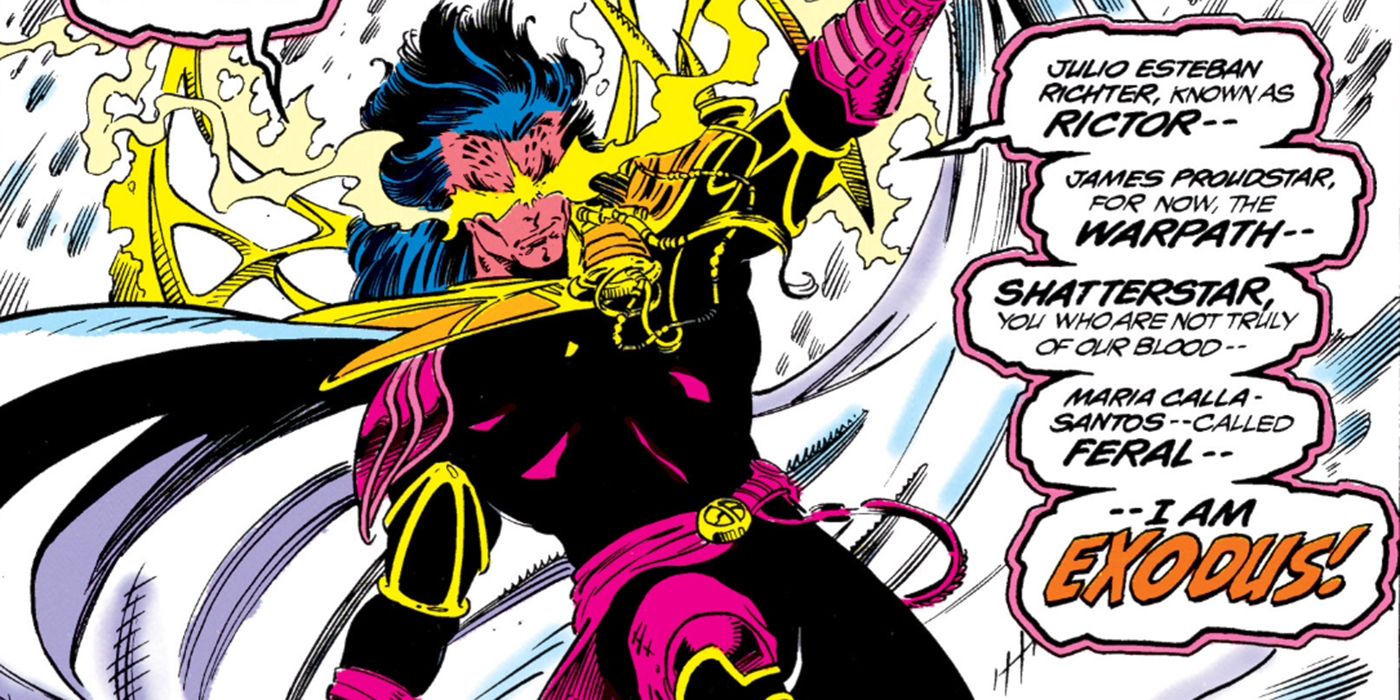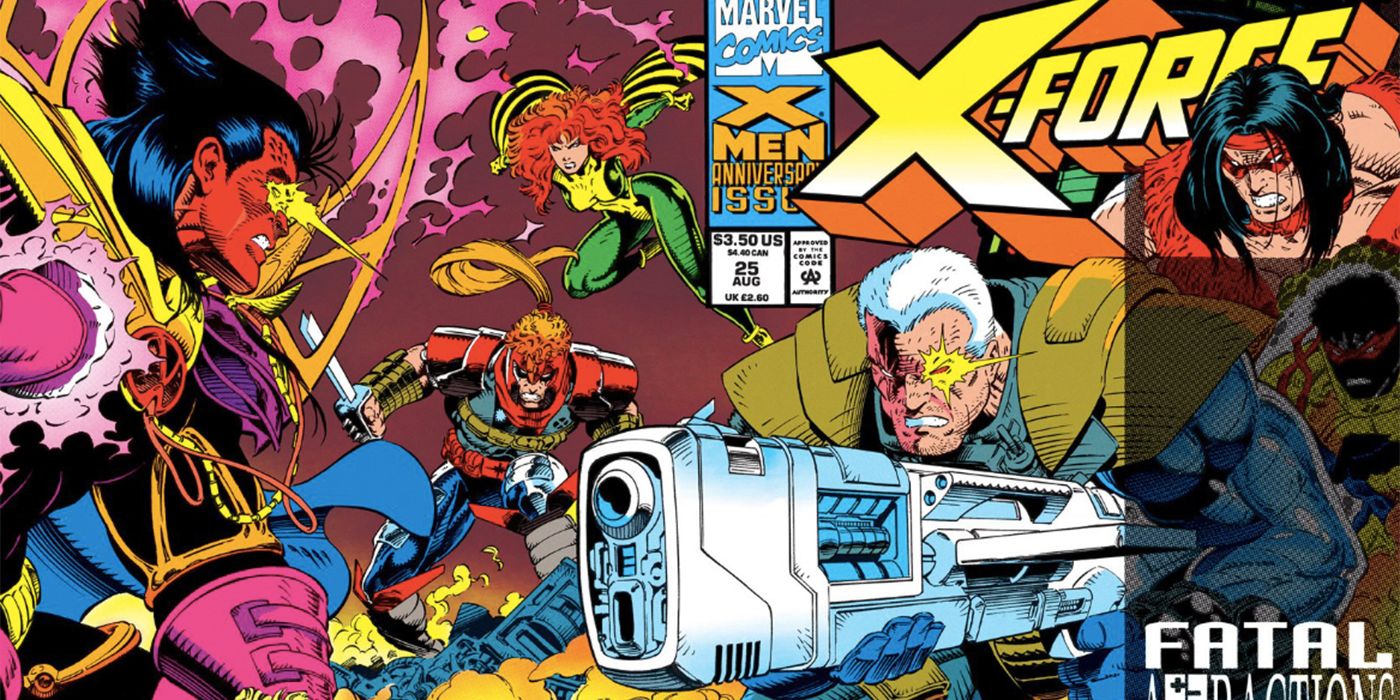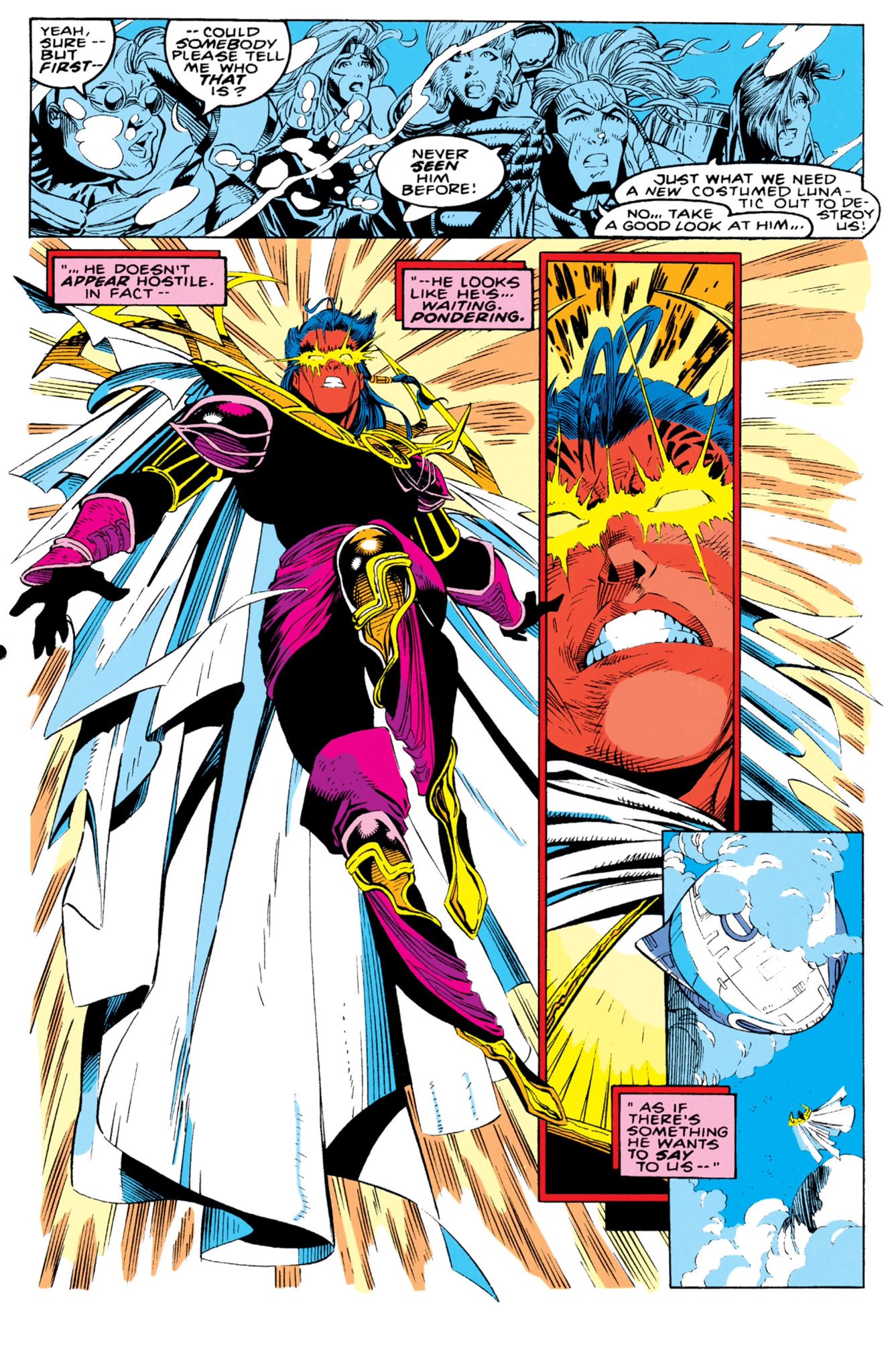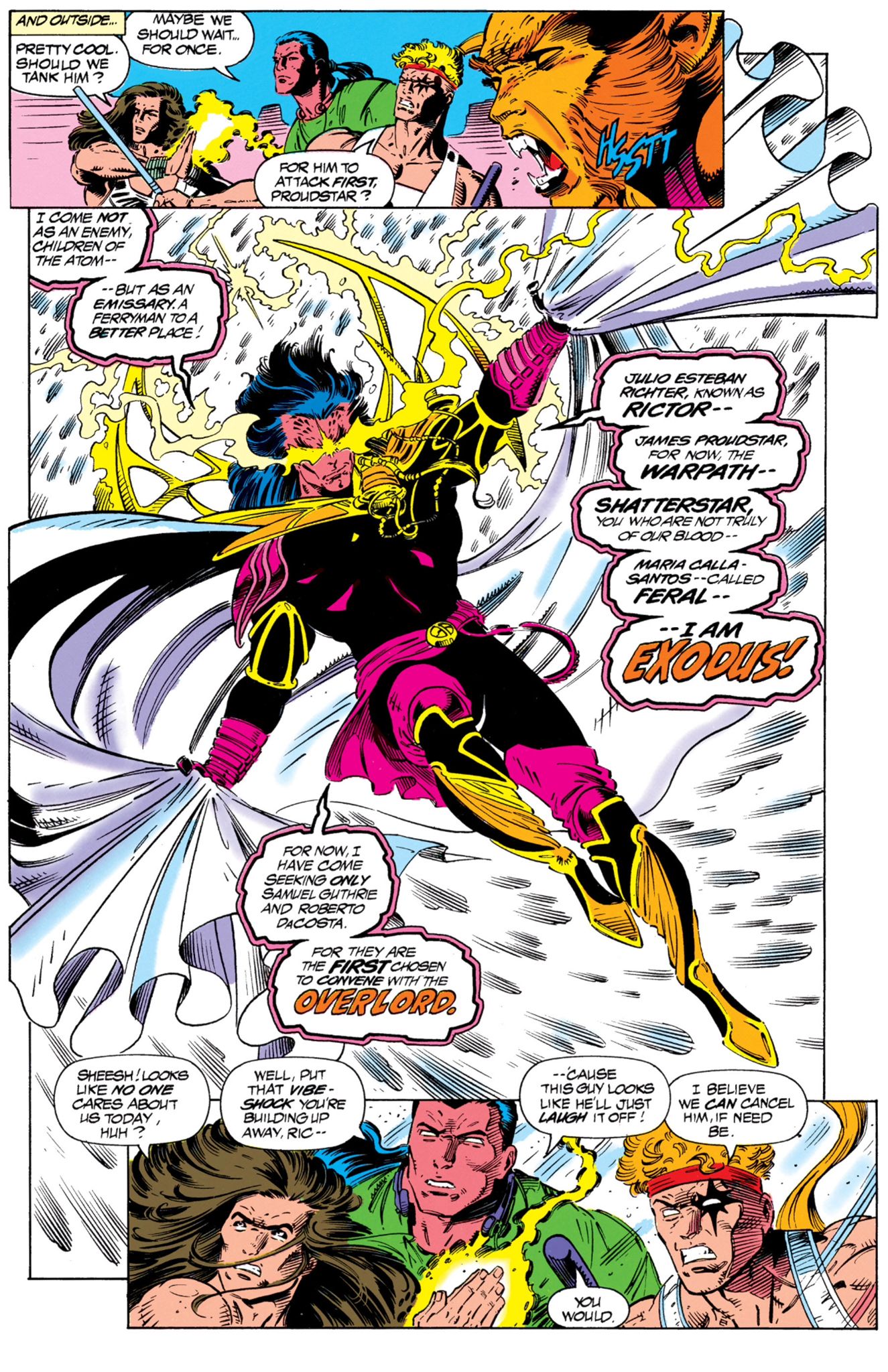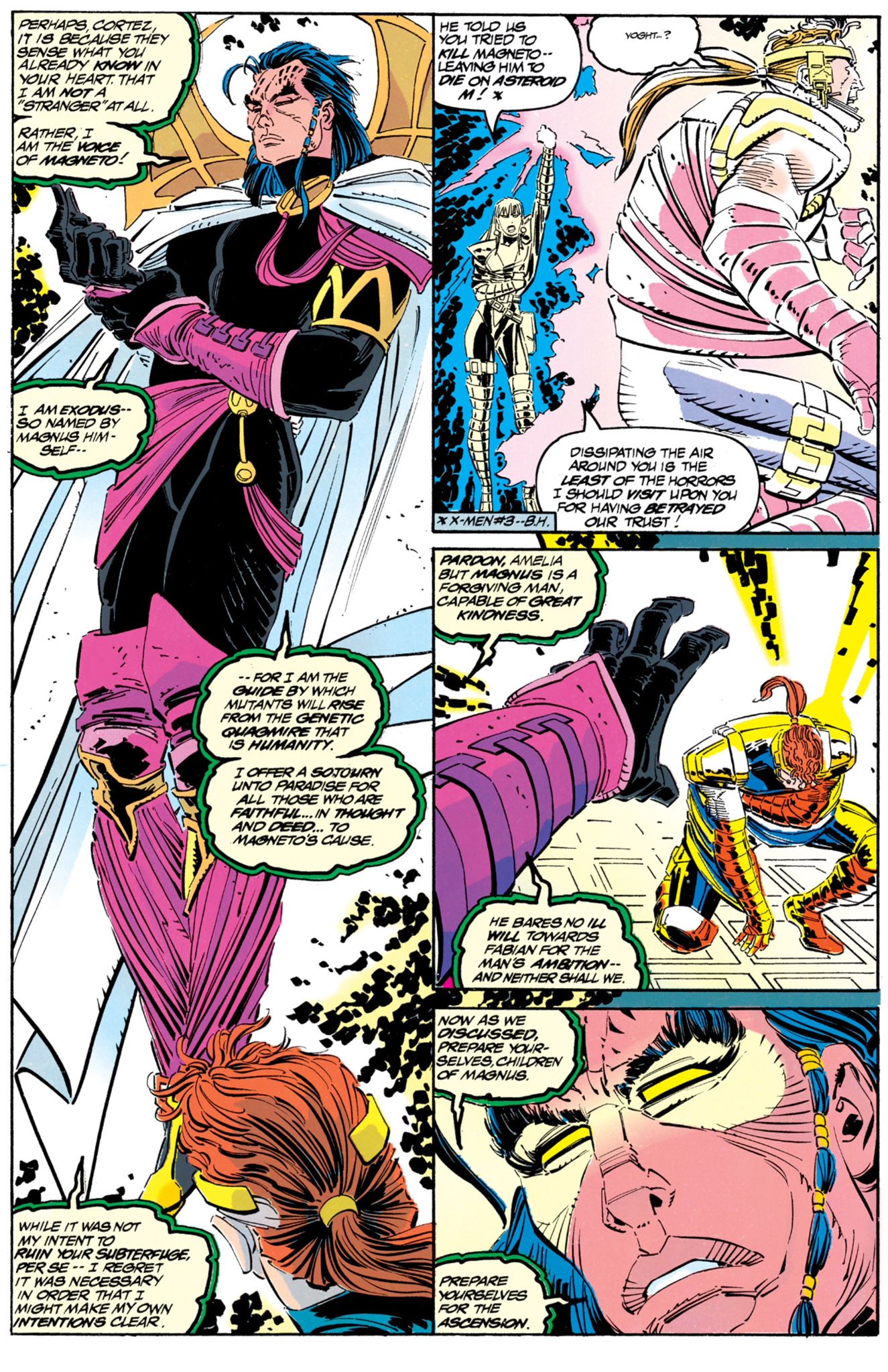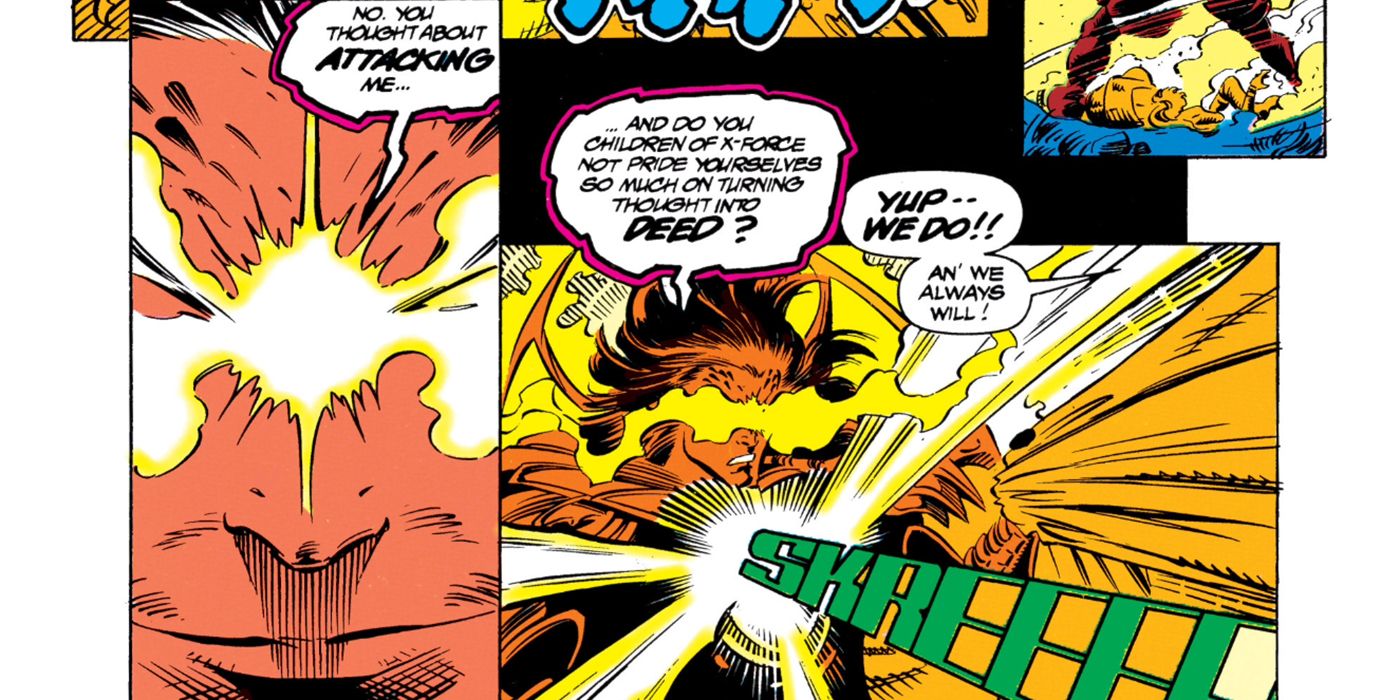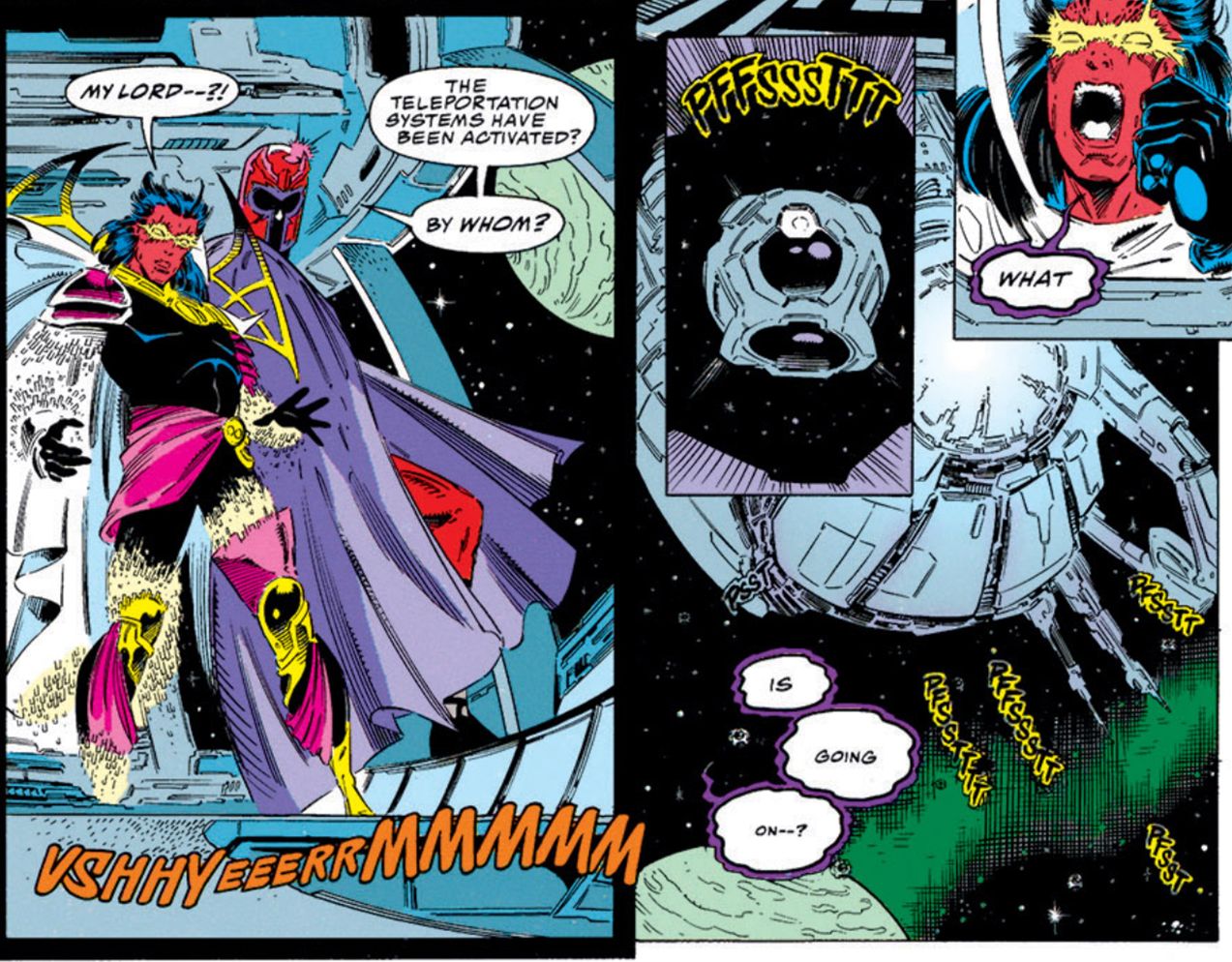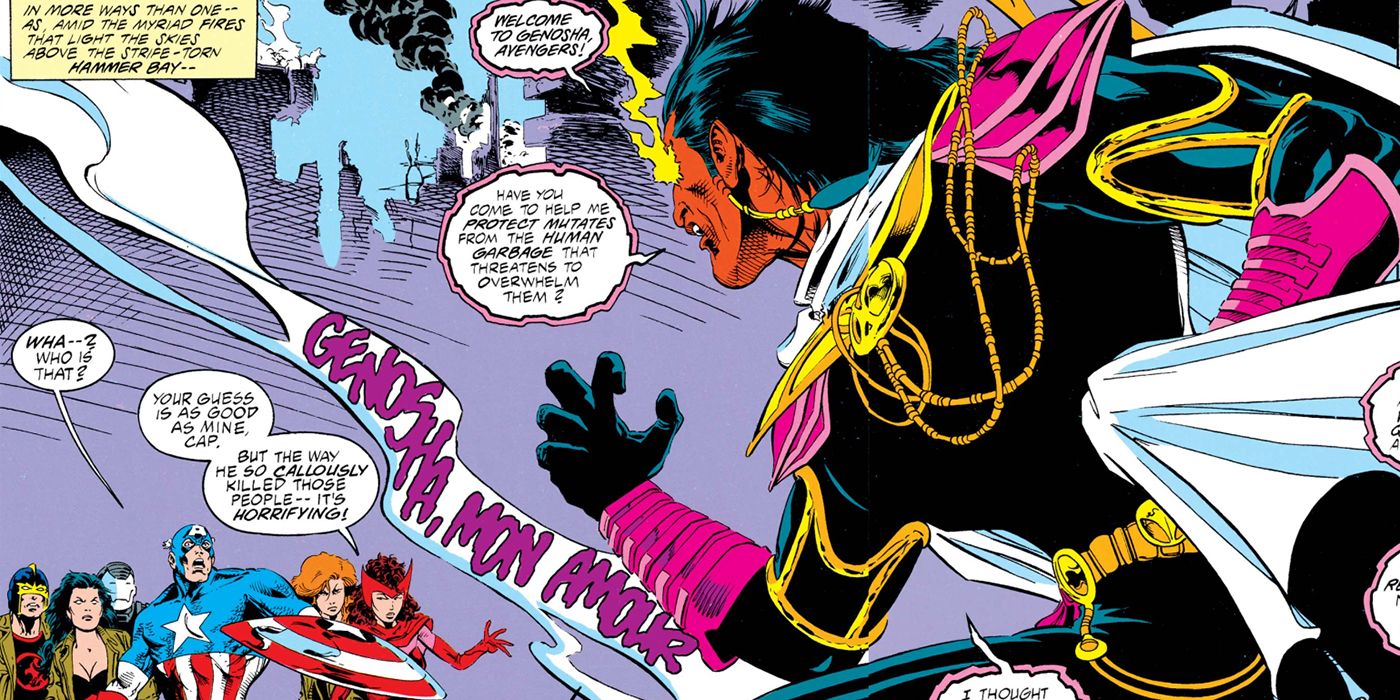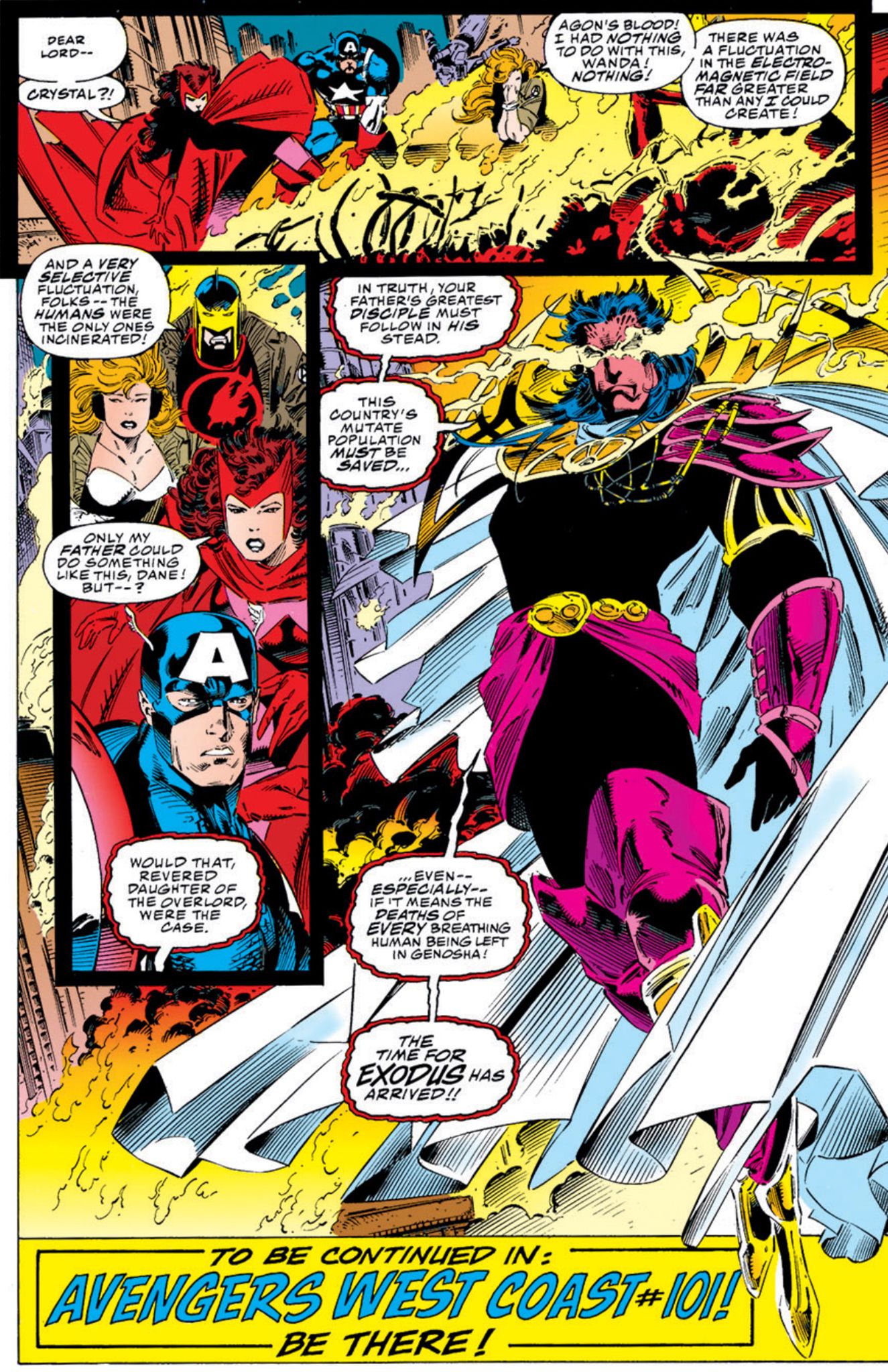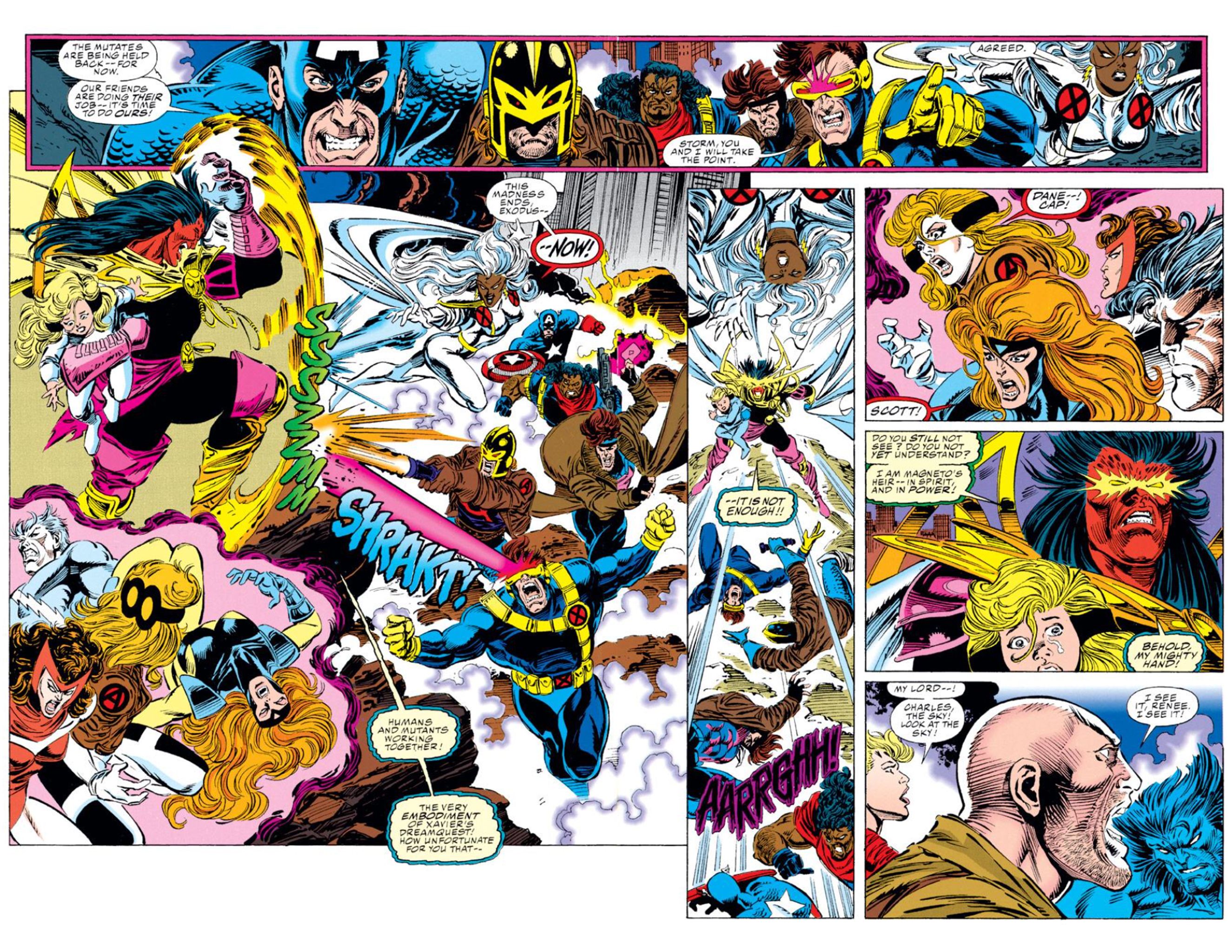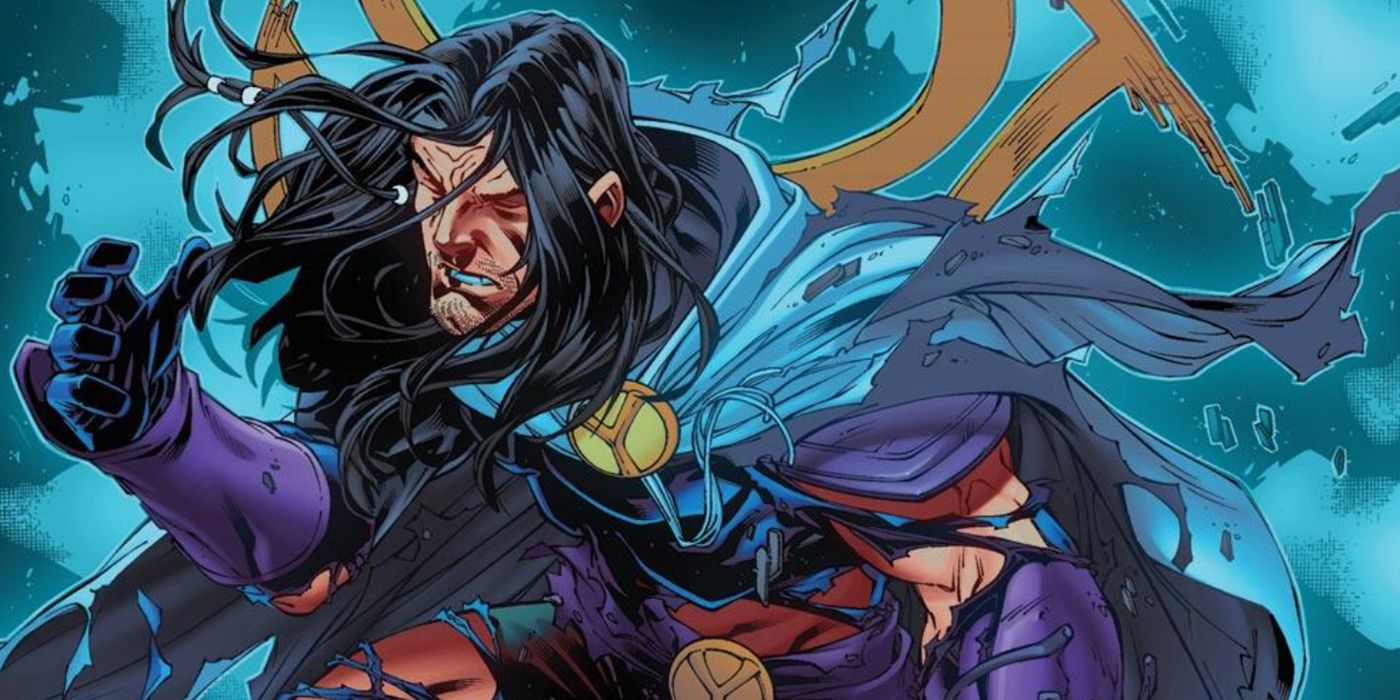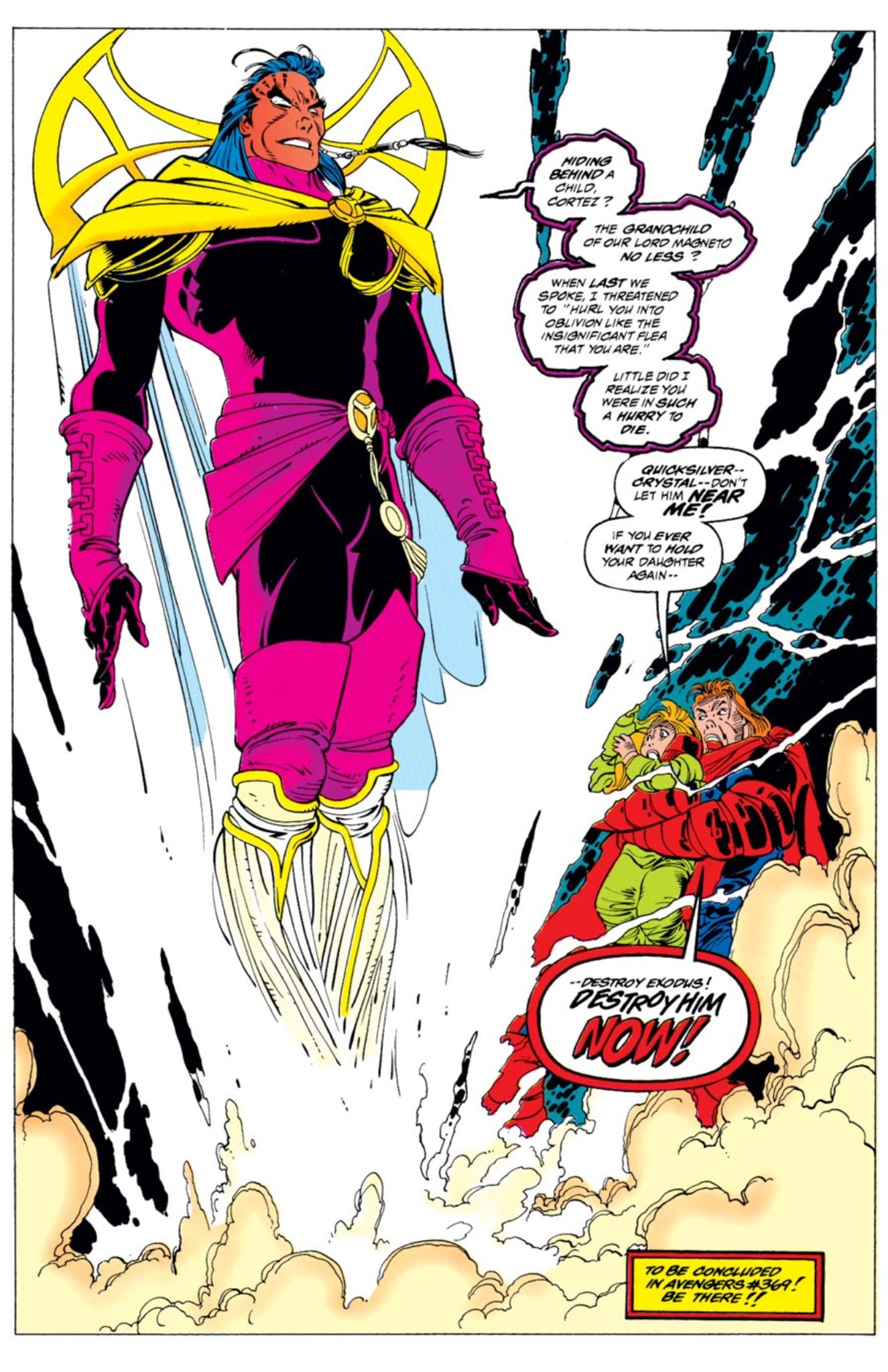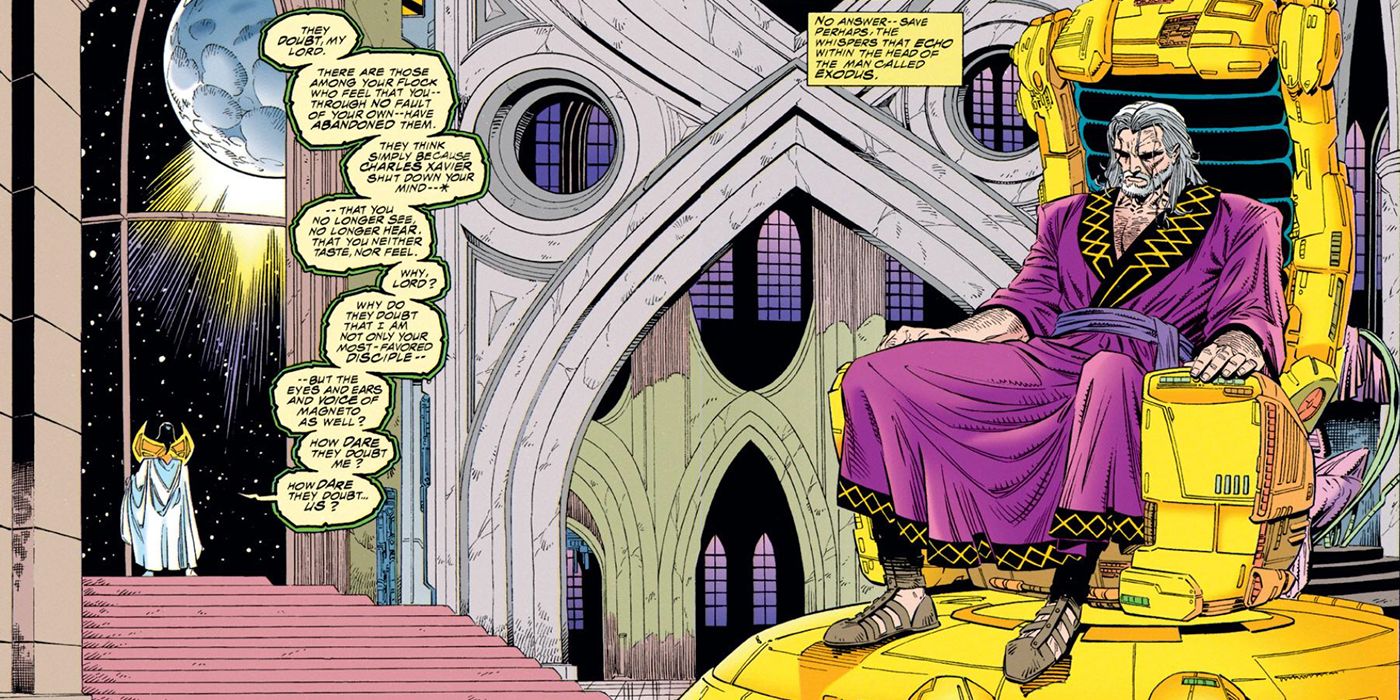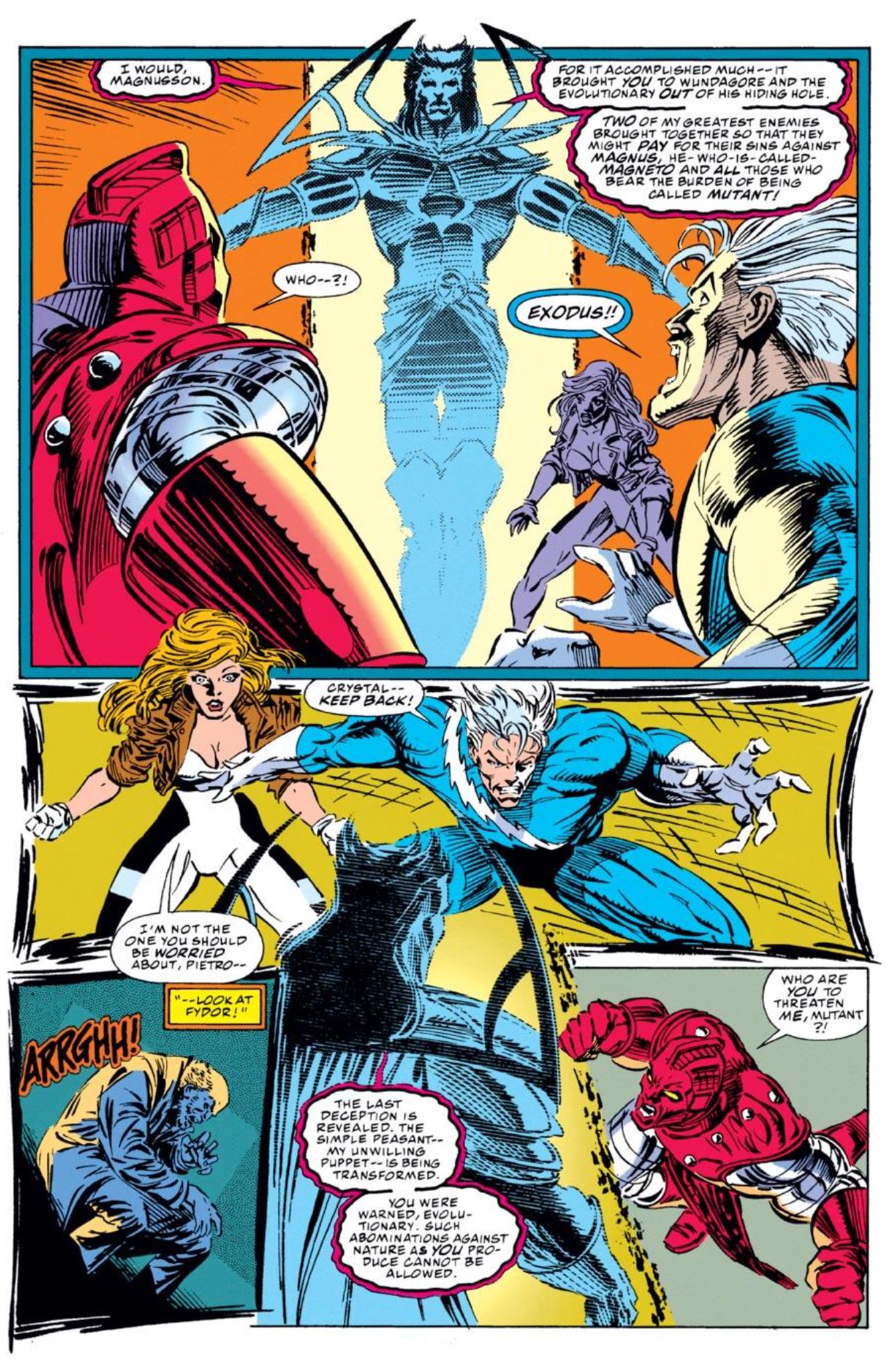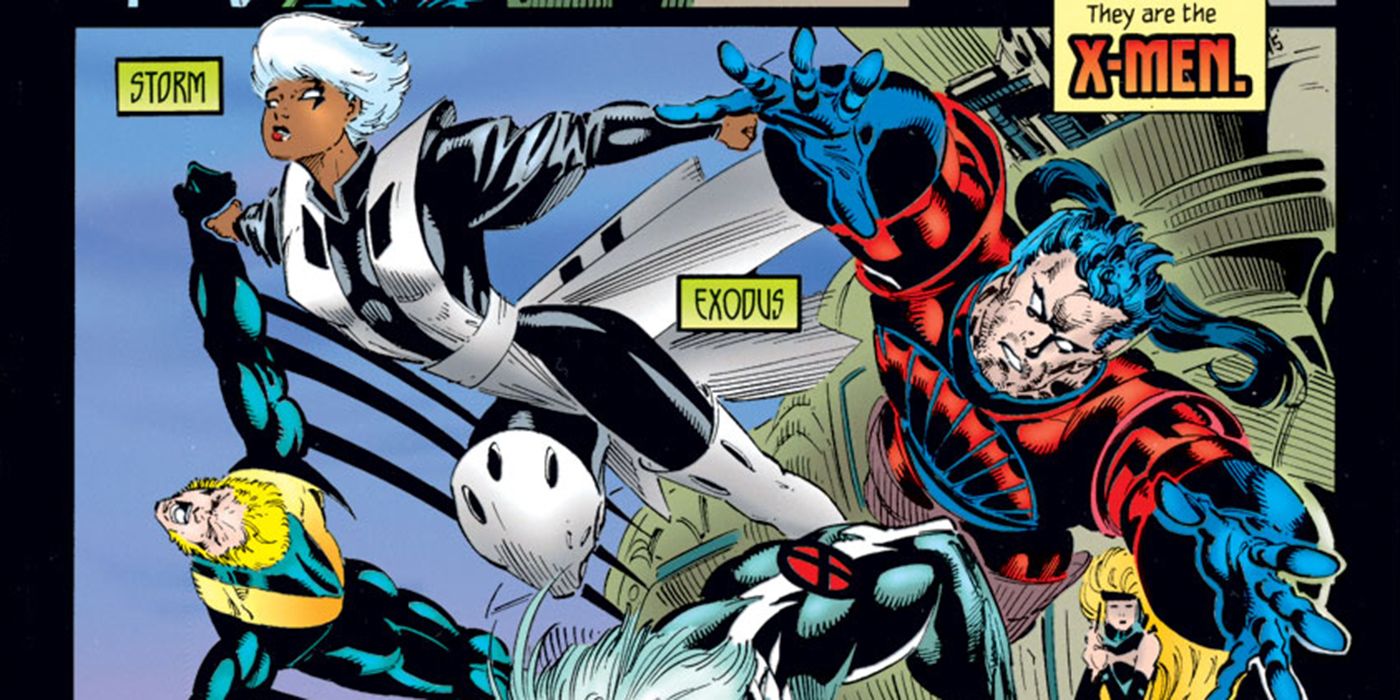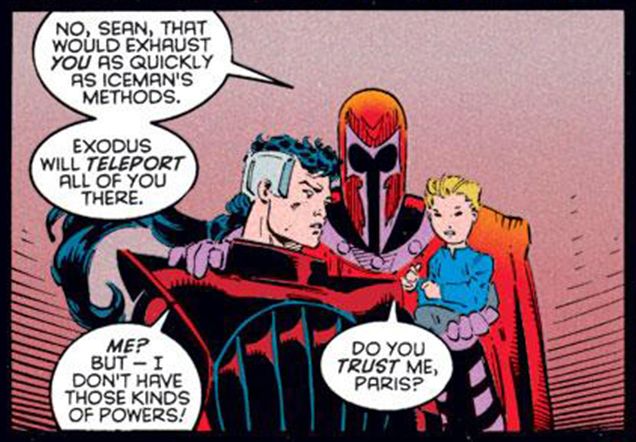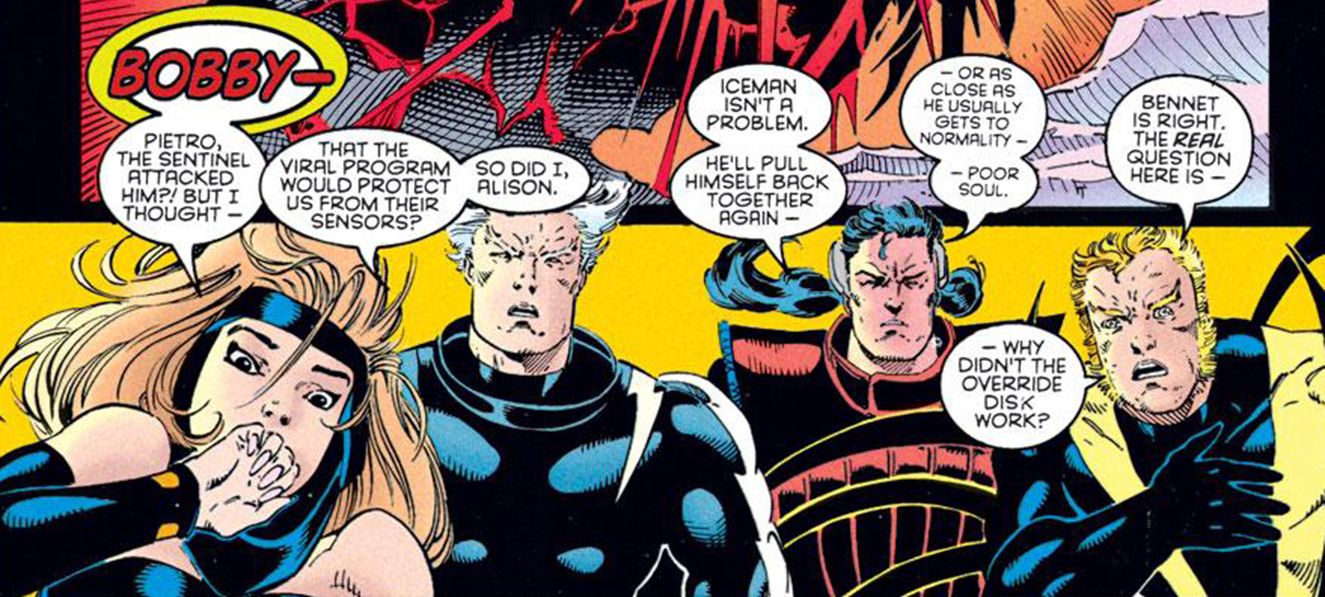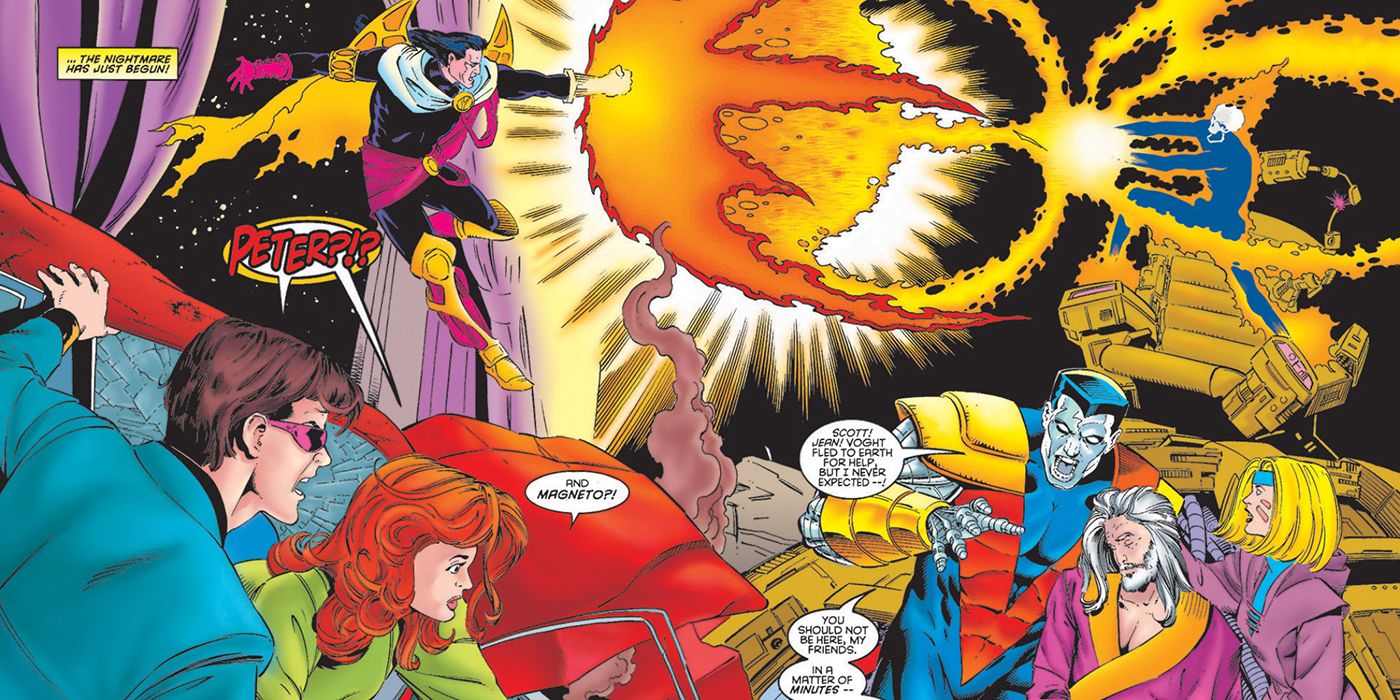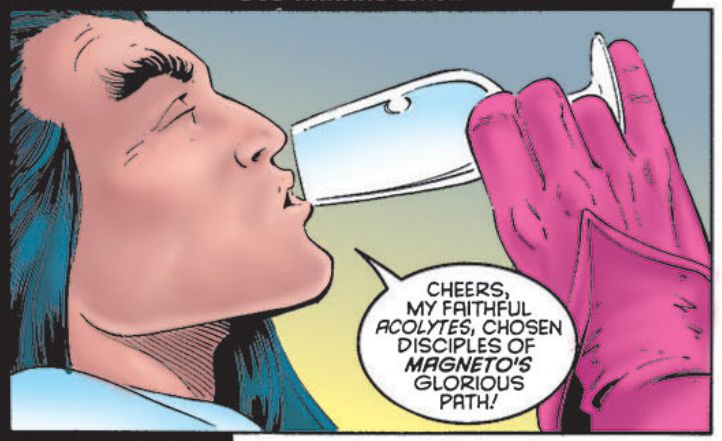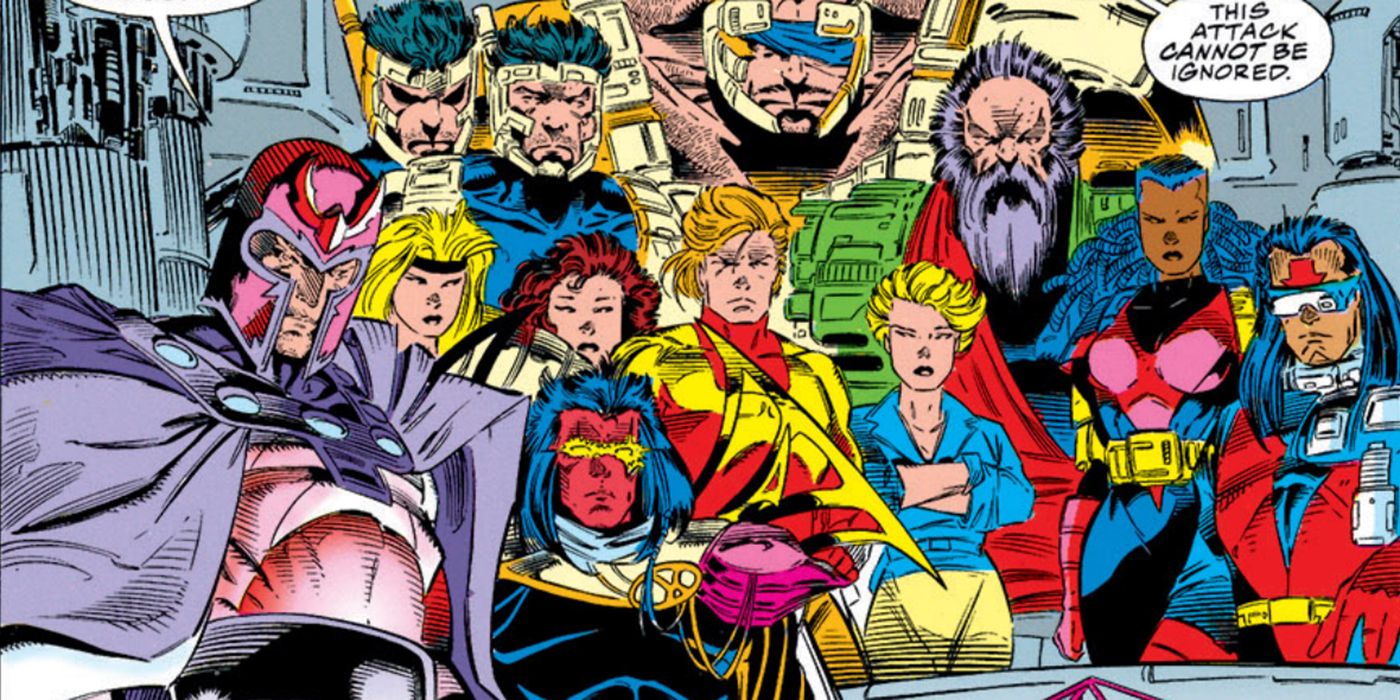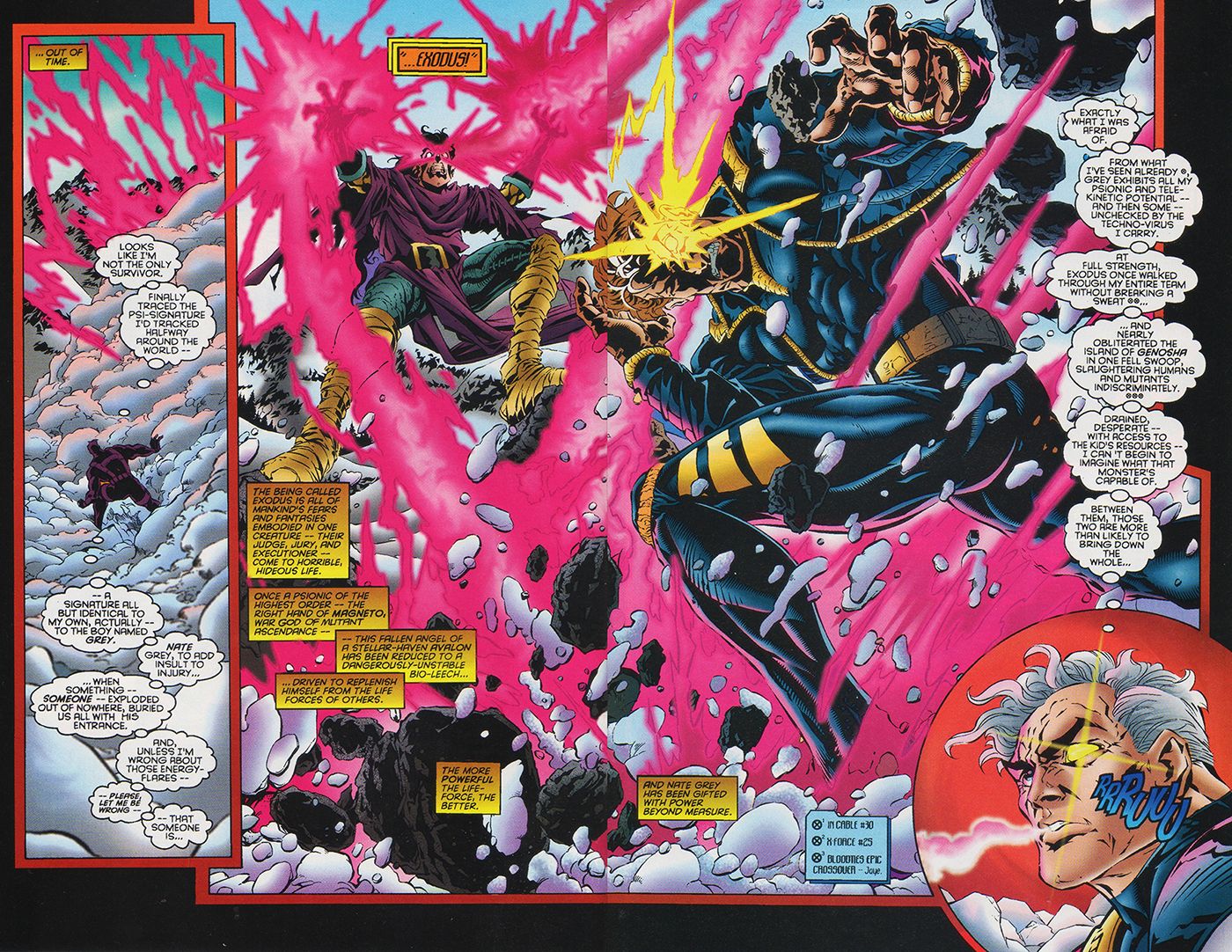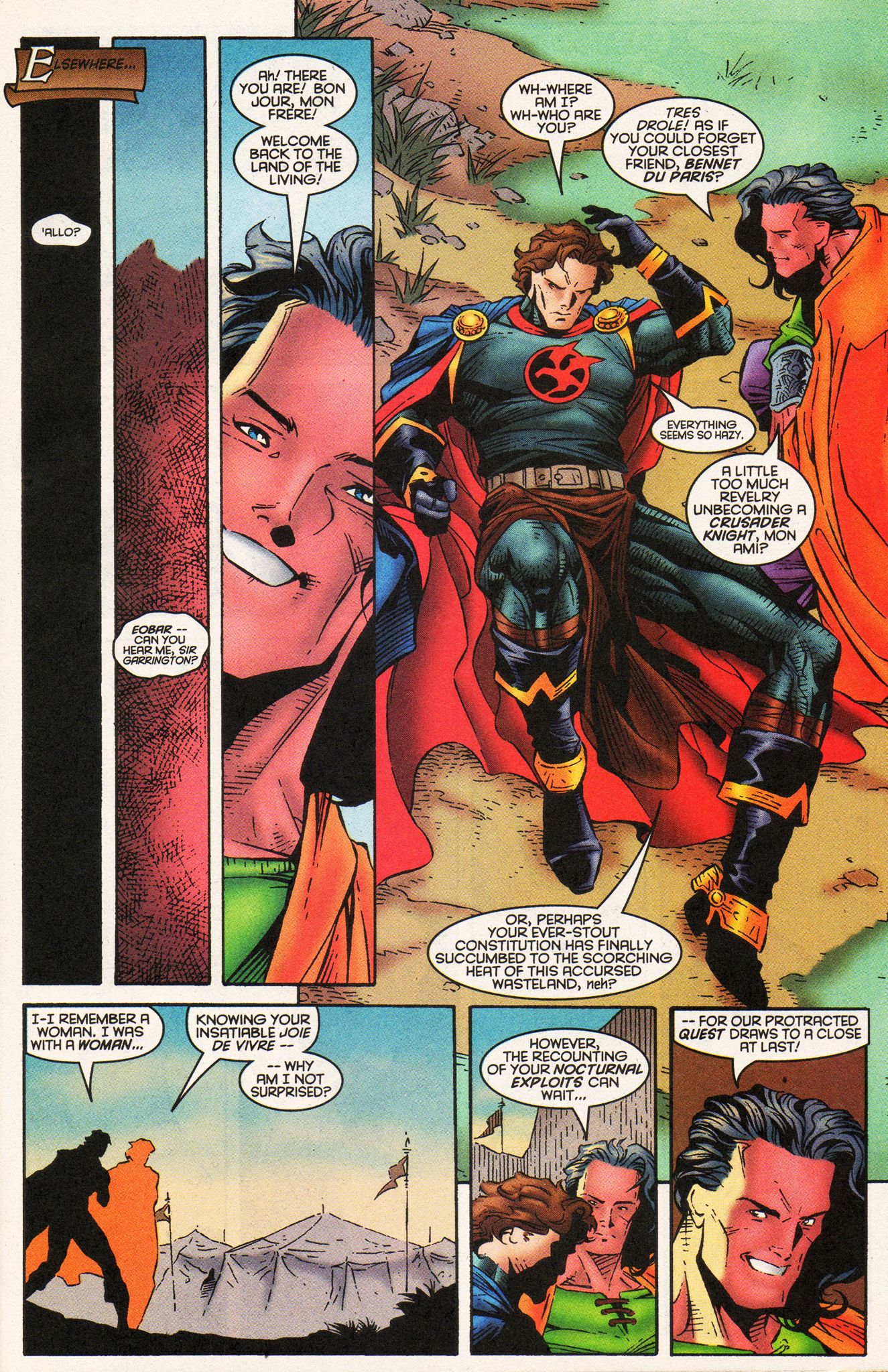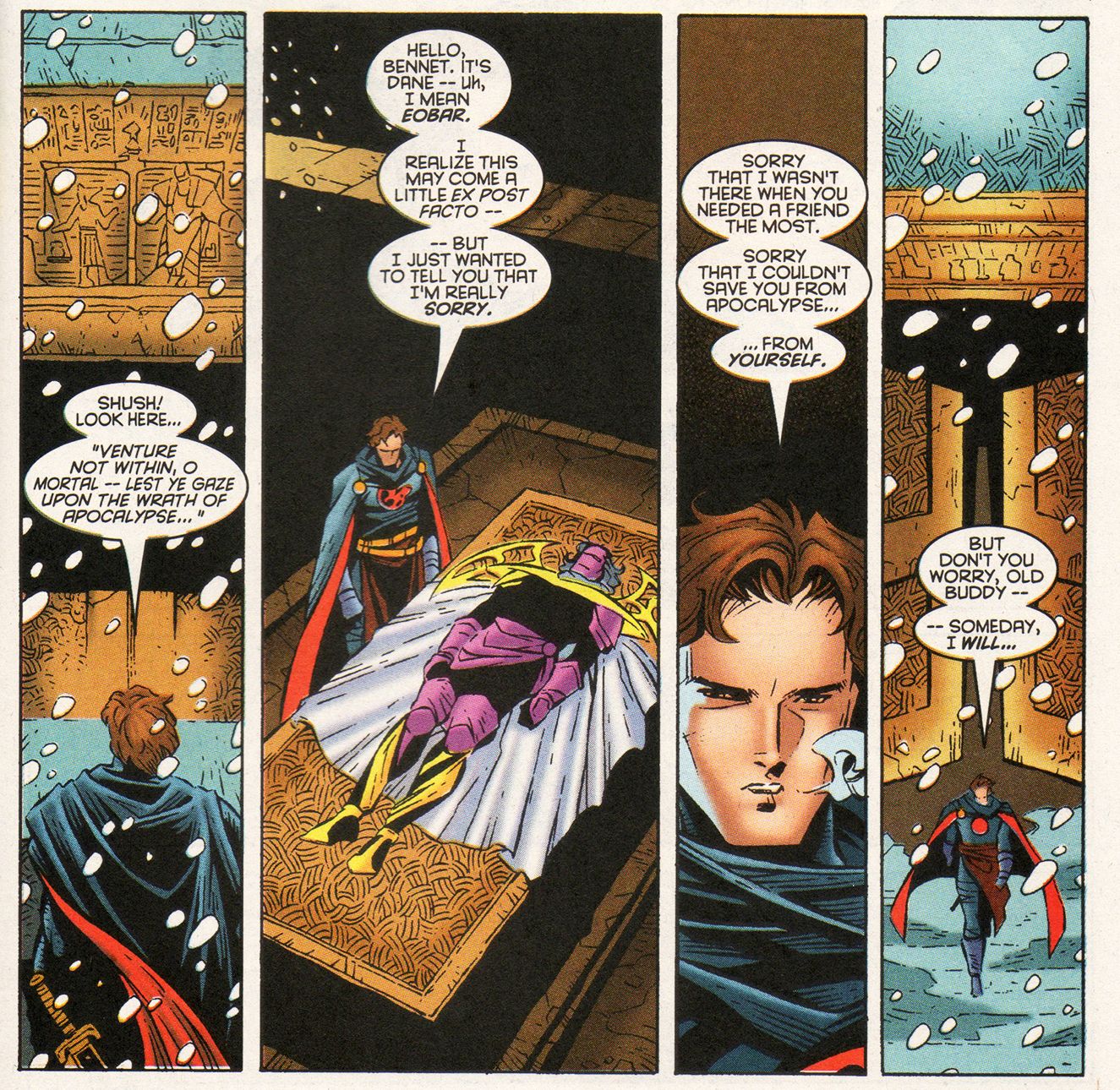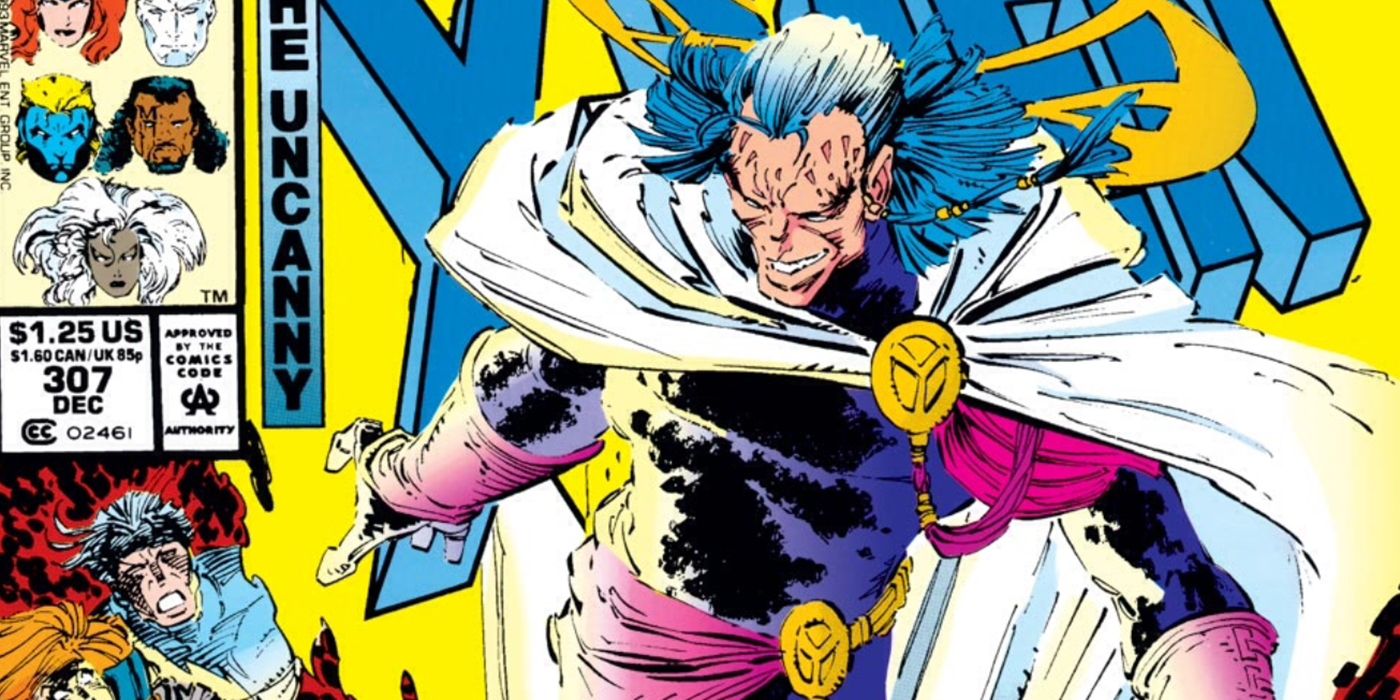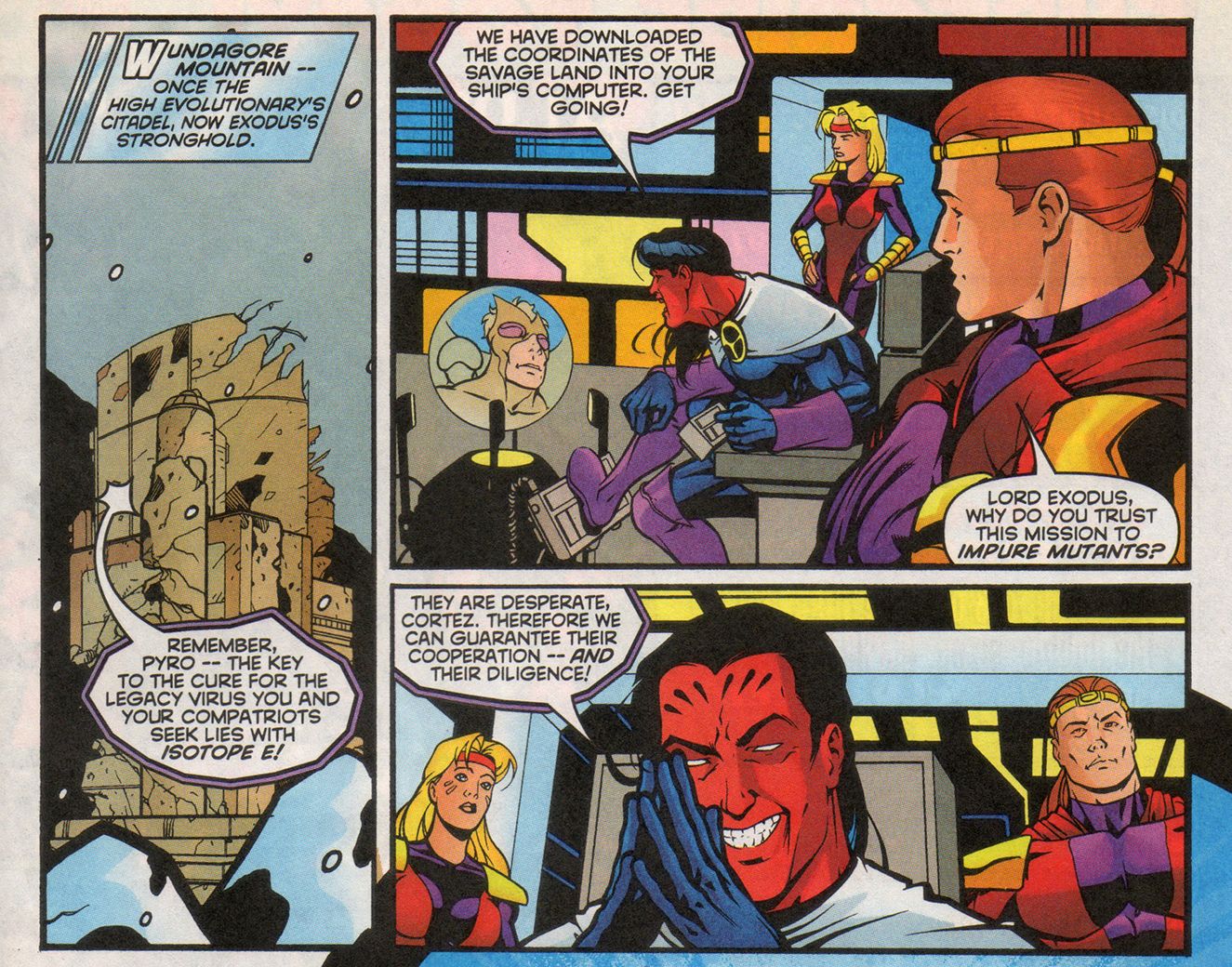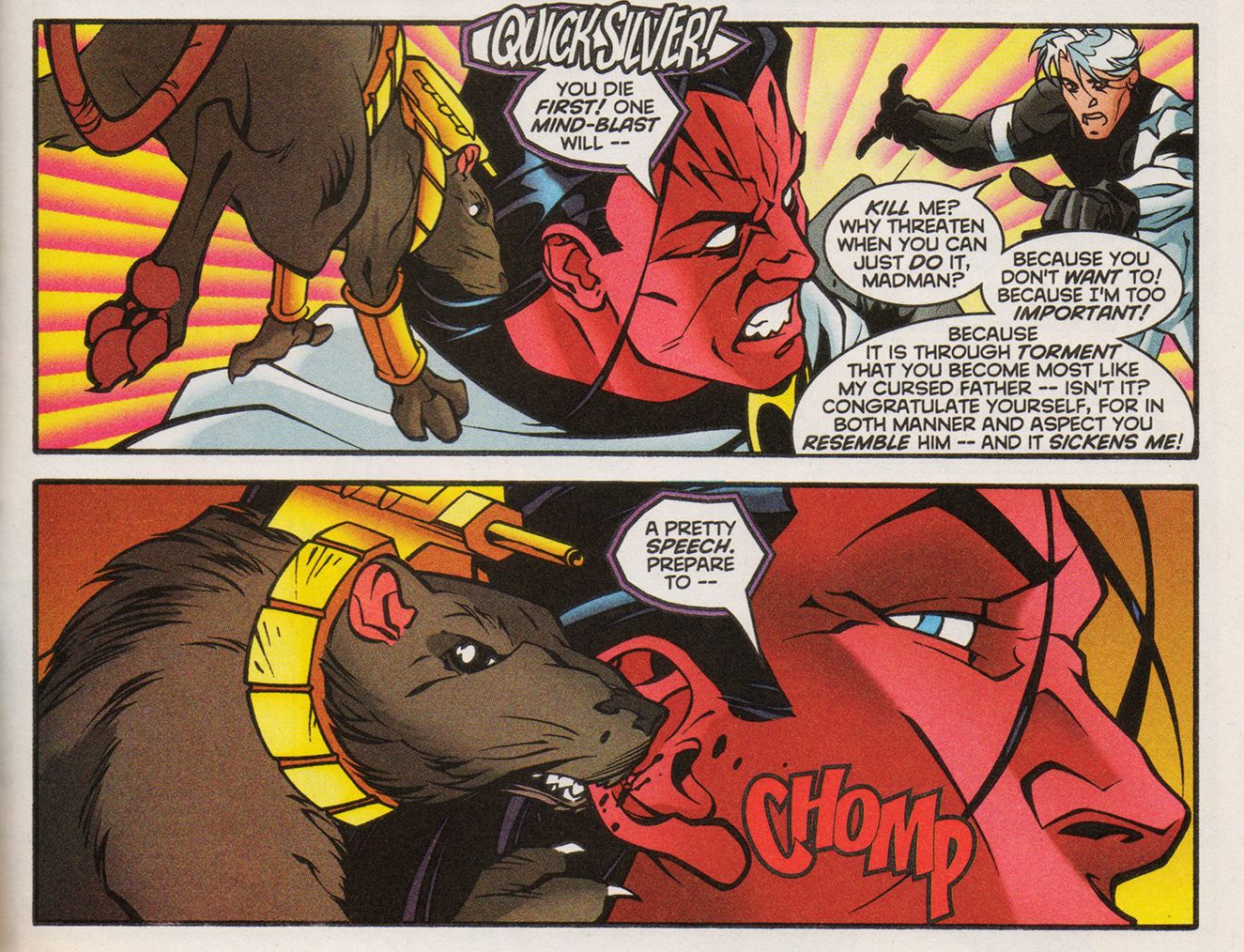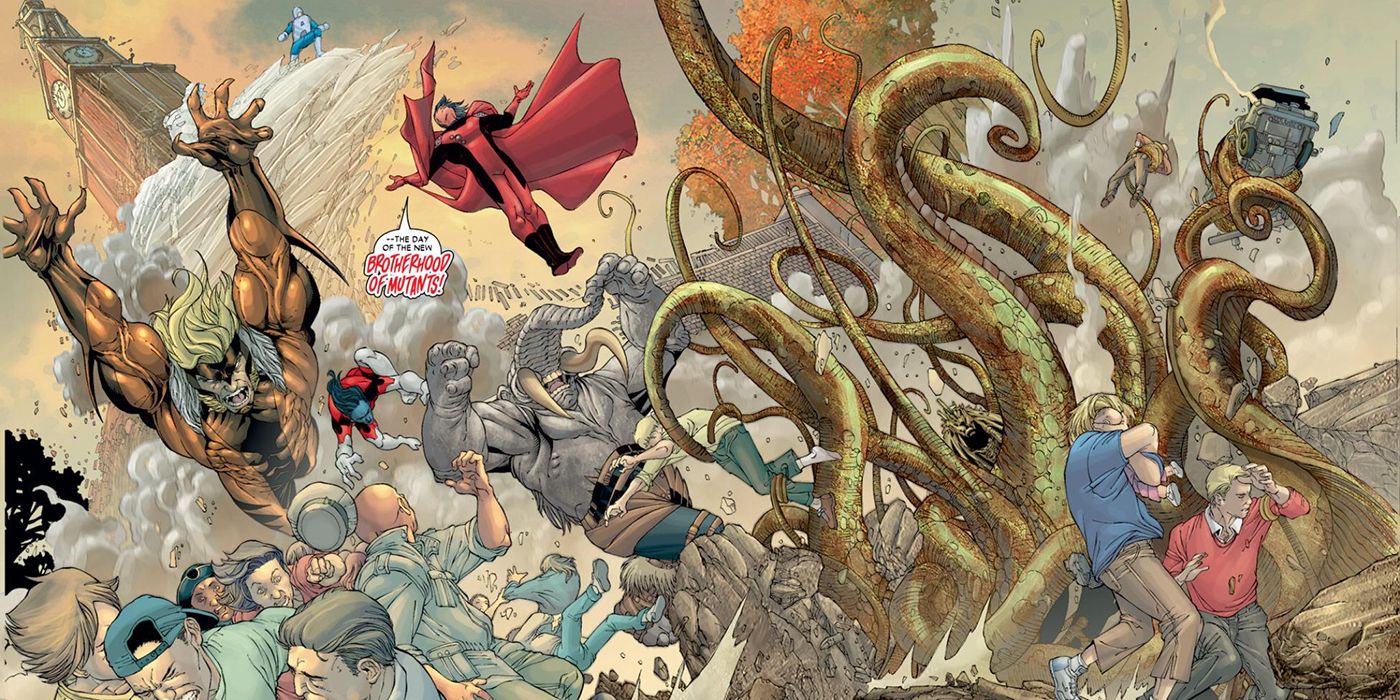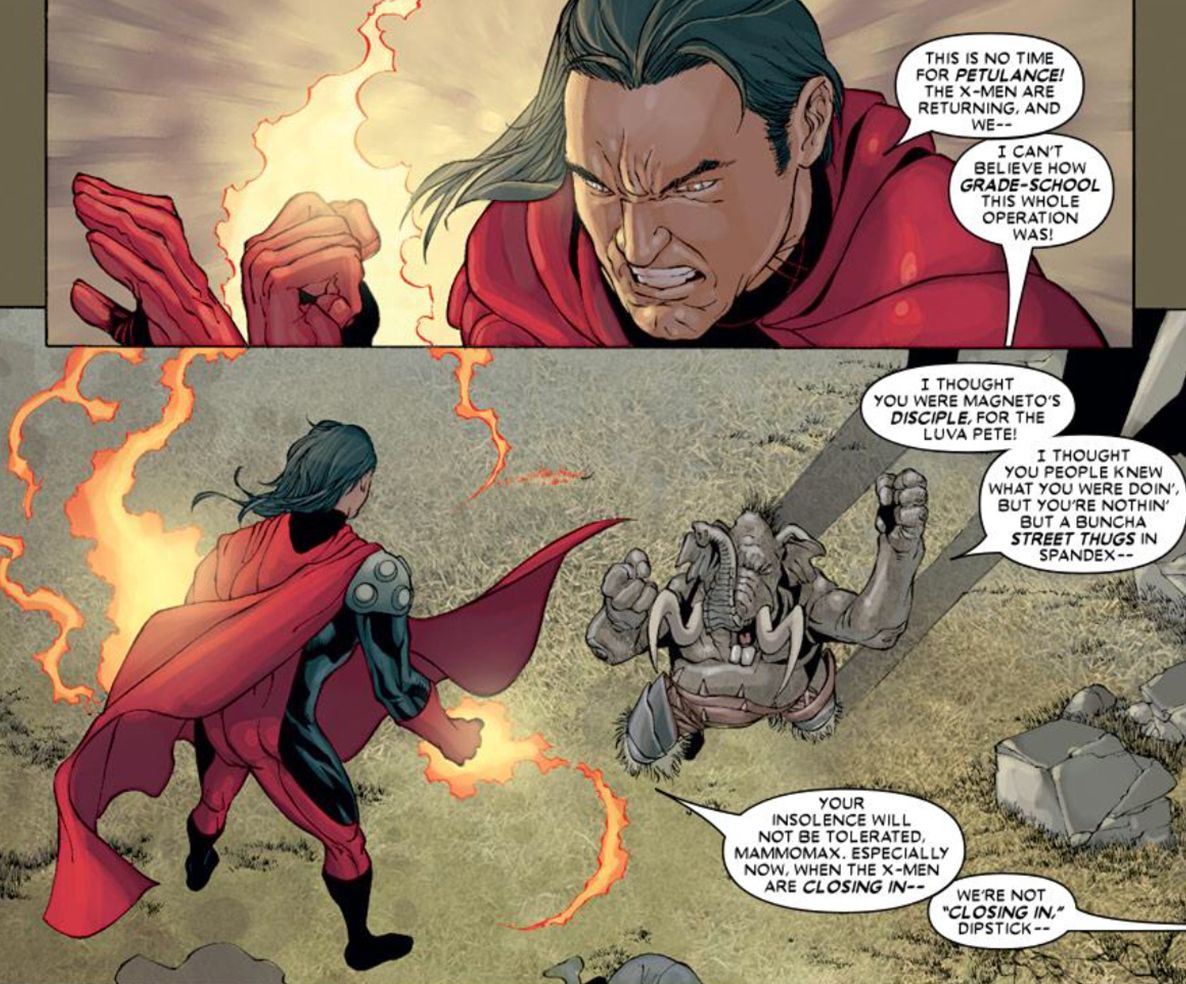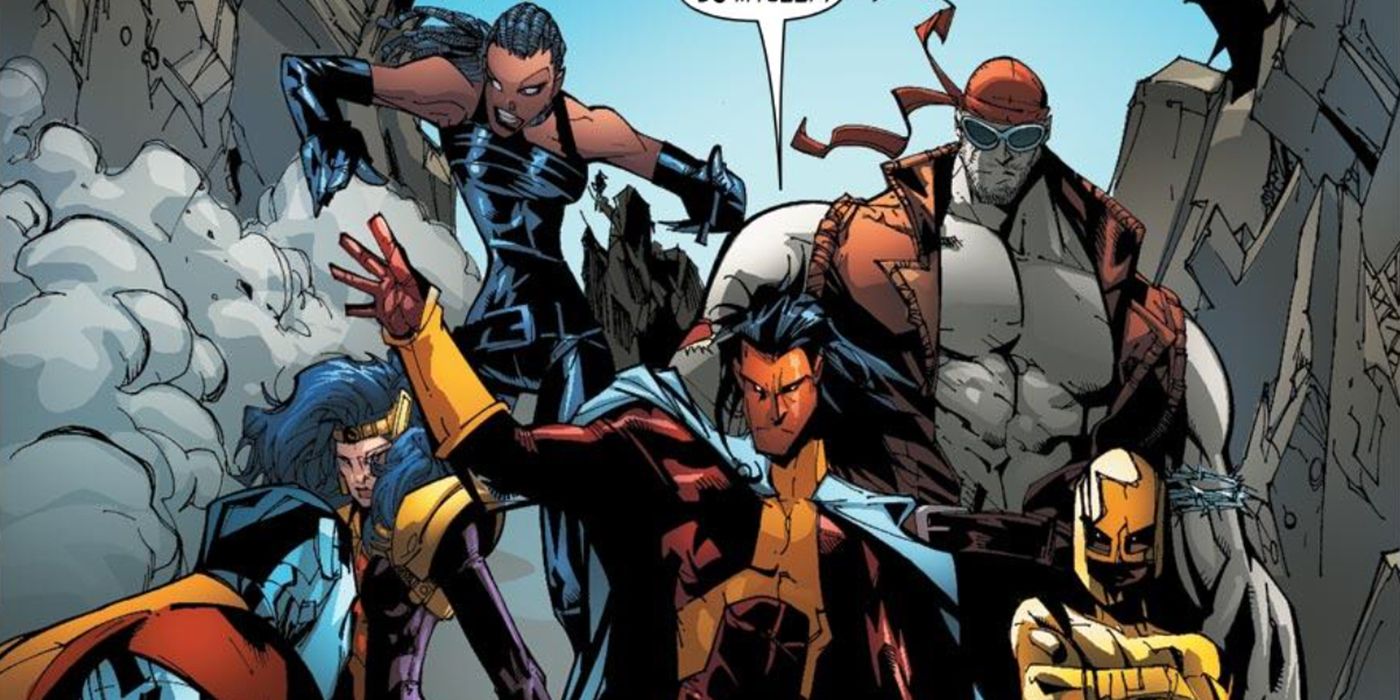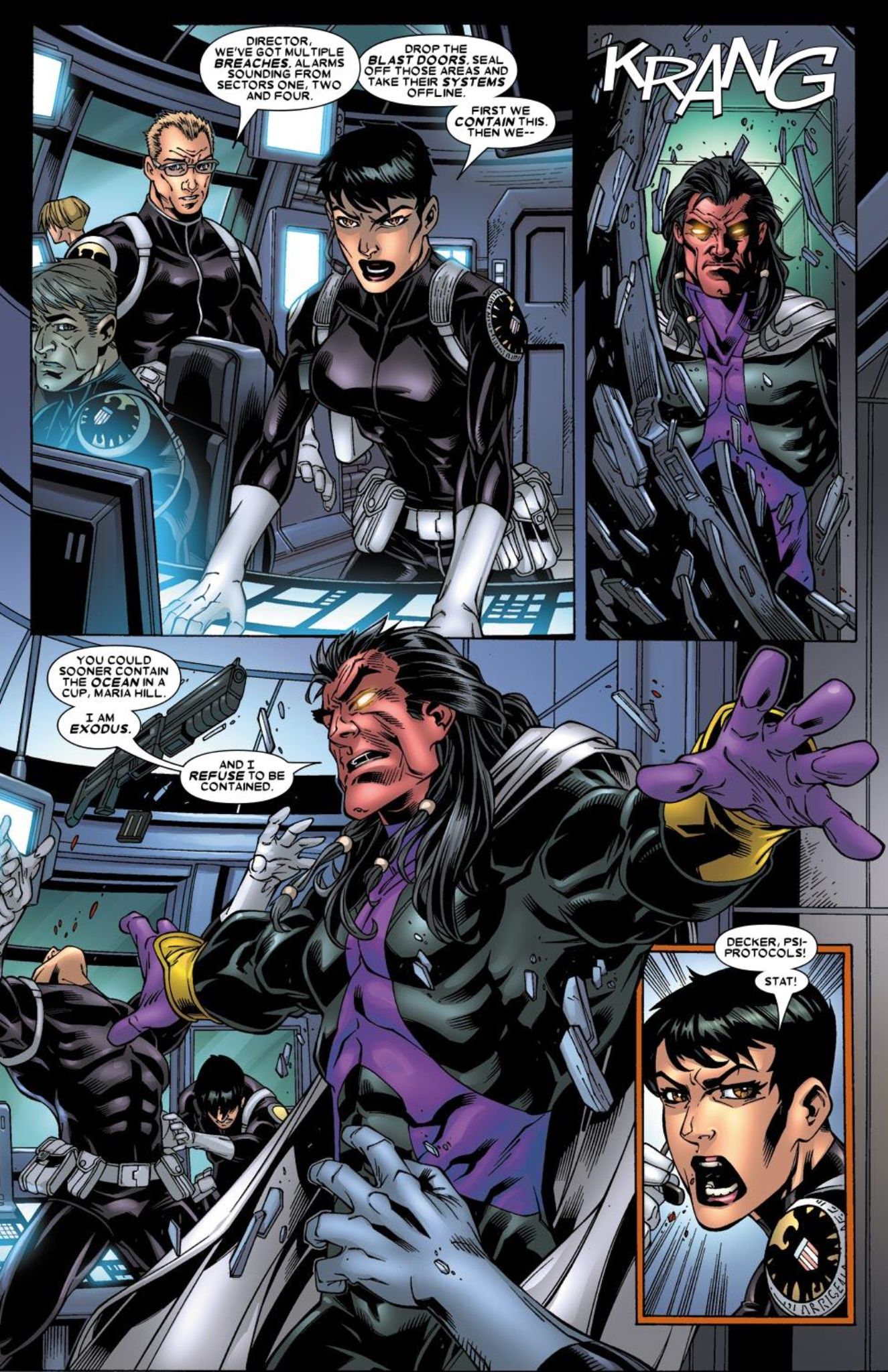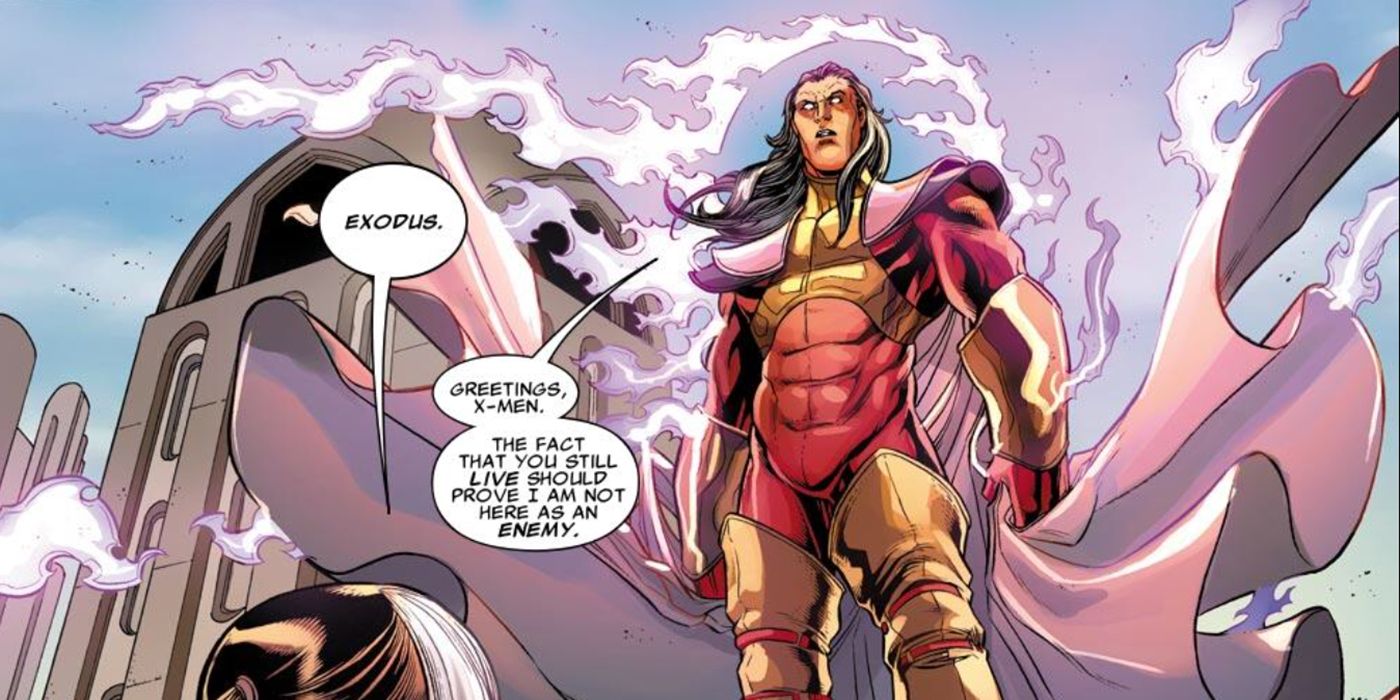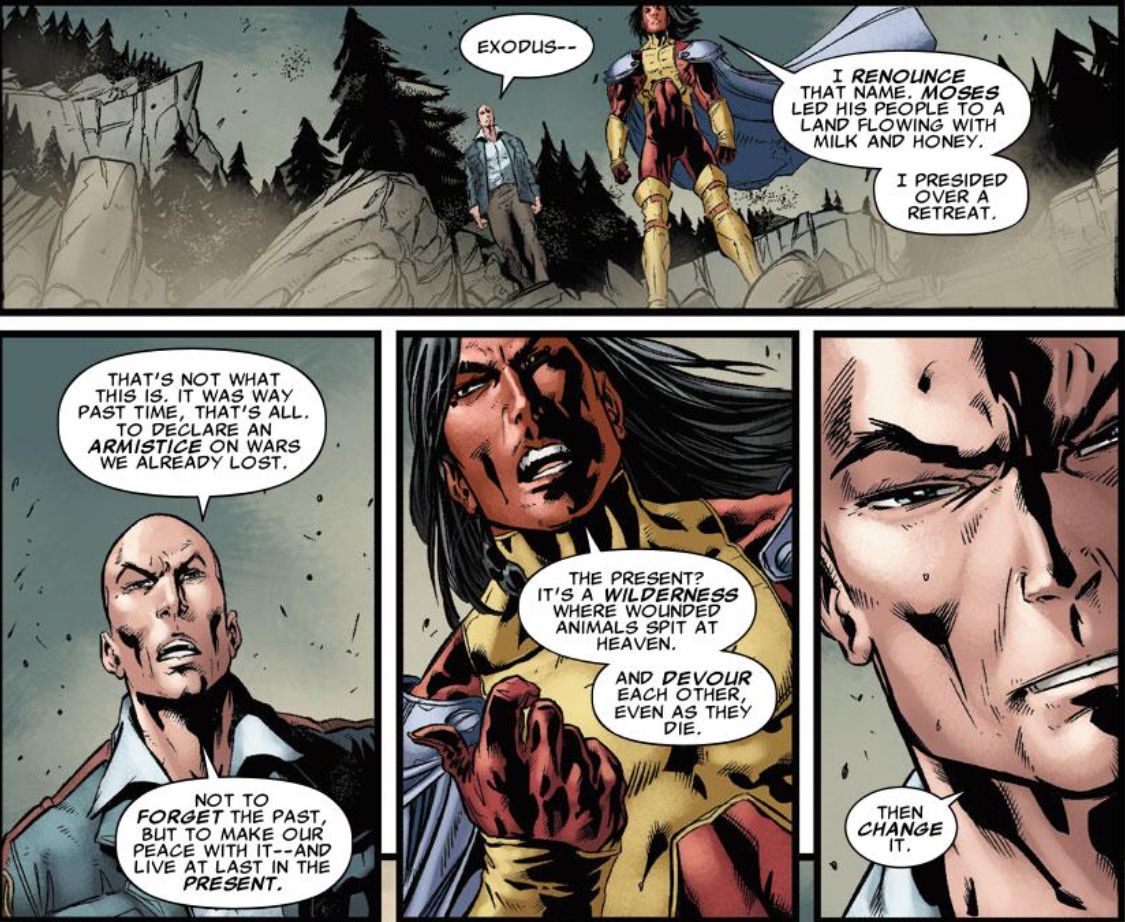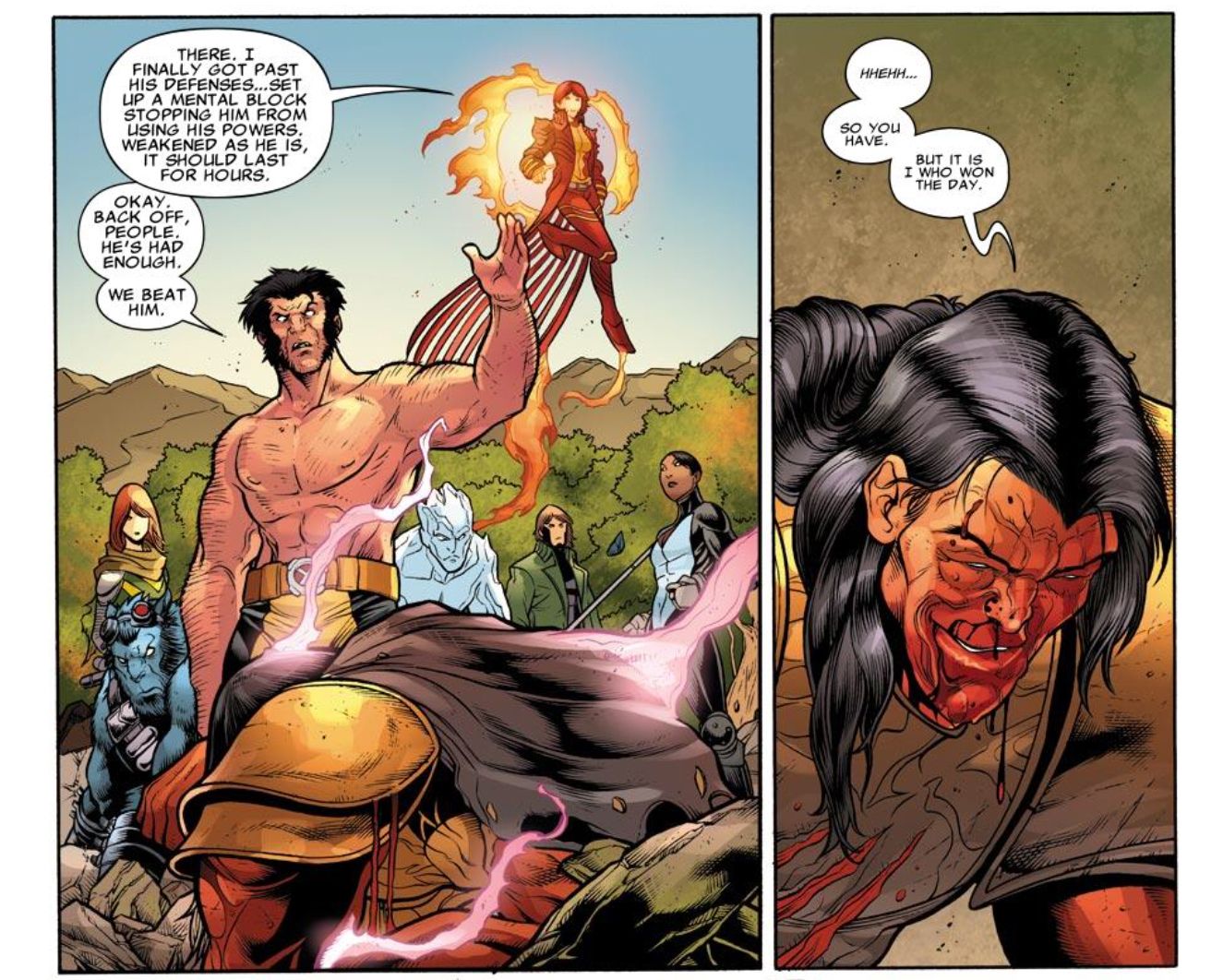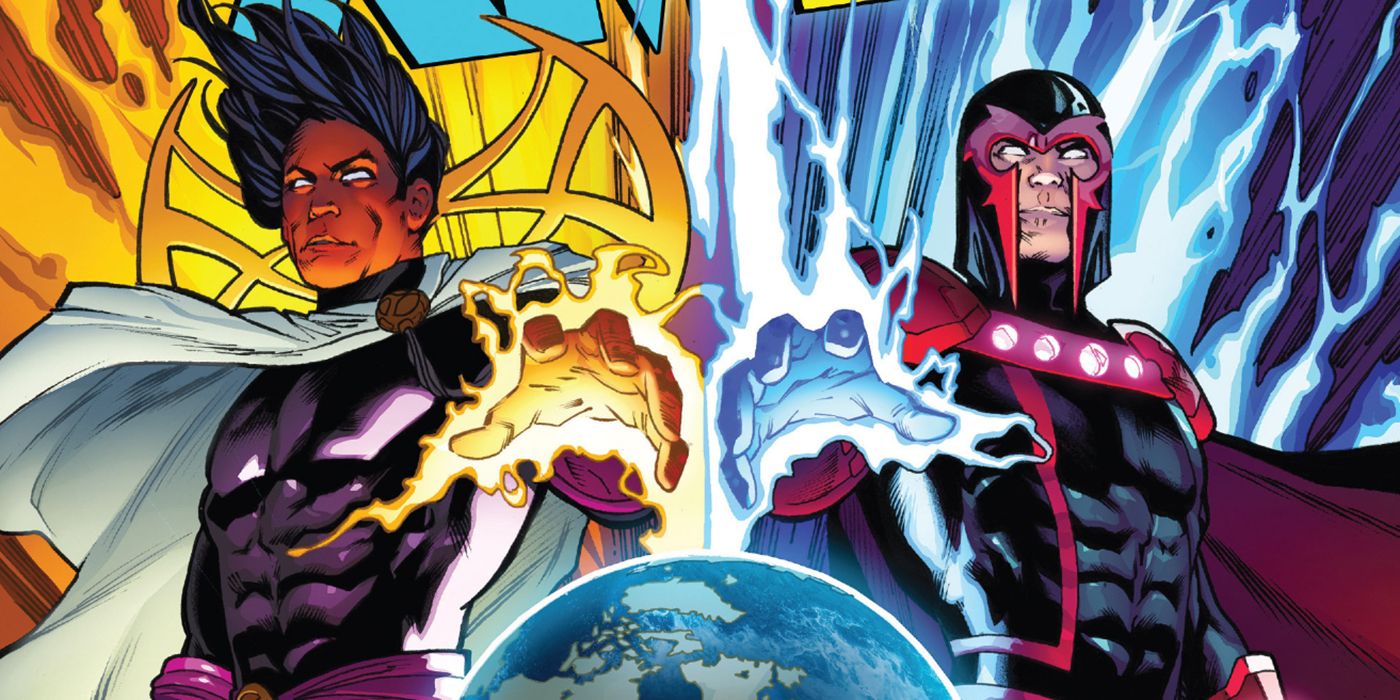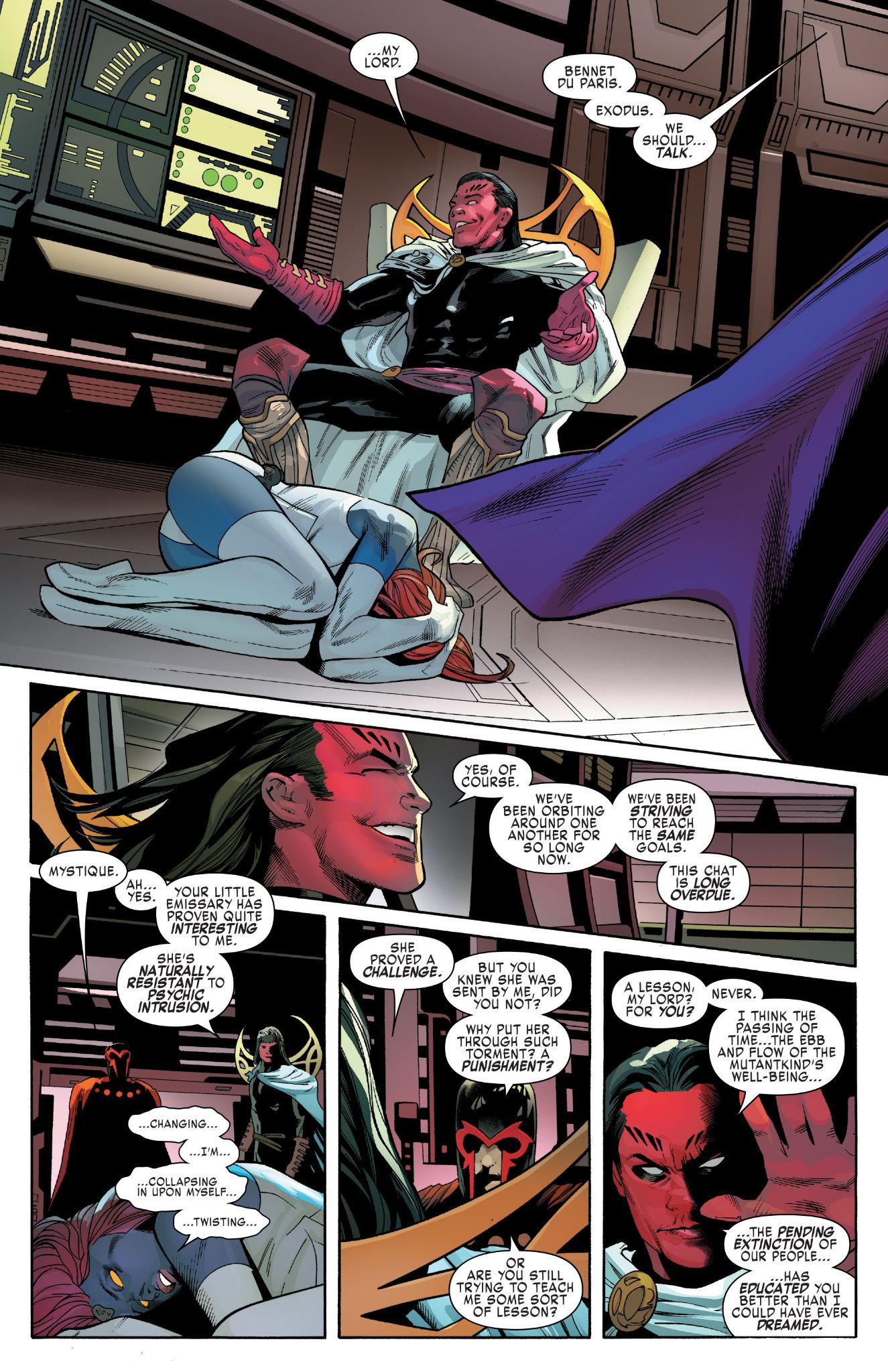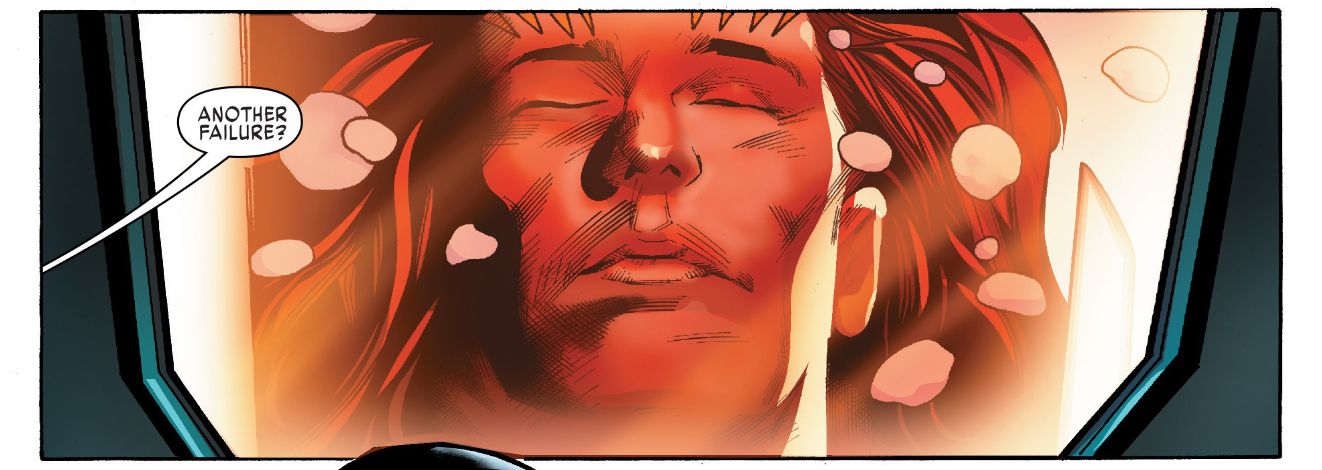Exodus.
If you're a completist X-Men fan who grew up in the '90s (like myself), then you know exactly who he is. He's an all-powerful worshiper of Magneto clad in white robes, fuchsia armor, little angel wings and Pearl Jam hair. Exodus was a big deal because he was treated like a big deal -- and then he went away.
Then he came back again! And then he went away. Then back! Then gone, then back and dead, and now -- as of September's "Uncanny X-Men" #13 -- back... and gone one more time. Whether or not you cared about Exodus' return hinges greatly upon when you started reading comics; if you're a 1992 kid, then this return was a big deal.
RELATED: [SPOILER] Makes An Explosive Return In Uncanny X-Men #13
Obscure X-Characters are like the spinach to my Popeye; if one returns, my research muscles flex. I wanted to know everything I could learn about this quasi-messiah, especially since he's the center of so much X-Men continuity. The guy has ties to Magneto, Apocalypse and Mister Sinister, and even some Avengers. He was everywhere -- and then nowhere. While researching Exodus, I realized I'd stumbled onto the guy that embodies the strengths and bewildering weaknesses of shared continuity superhero comics. Buckle up, because this is going to be a ride.
NOTE: This list is not a countdown, but rather a point-by-point recounting from Exodus' first appearance to his latest.
15 Fatal Attractions
Exodus debuted in May 1993 in a silent cameo in "X-Factor" #92, written by Scott Lobdell, Joe Quesada and J.M. DeMatteis.
Based on what we learn in his next appearance, "X-Force" #25, we can assume that he was scouting X-Factor for recruitment. Exodus burst into "X-Force" #25 serving as his own hype man, proclaiming himself the "emissary" and "ferryman" to a better place.
That better place was Avalon, a surprise-not-dead Magneto's space station. Writer Fabian Nicieza -- already the fourth guy to write this character in just two appearances -- used a quick fight scene to establish Exodus as psionic powerhouse. Exodus' recruitment drive continued in "X-Men Unlimited" #2, also by Nicieza, where he pulled the dropping-from-the-sky-speeching business on the Brotherhood of Evil Mutants.
At this point in X-History, Magneto was presumed dead while his followers, the Acolytes, blindly followed Fabian Cortez (the guy that secretly orchestrated Magneto's death). Exodus finally crossed paths with Cortez and his Acolytes in "Uncanny X-Men" #304 (written by Lobdell) and blew up Cortez's spot.
The Acolytes followed Exodus back to not-dead Magneto's side -- and then they promptly crashed a six-year-old's funeral at Xavier's. "X-Men" #25 proved to be the first major turning point for Exodus. During a fight on Avalon, Professor X mindwiped Magneto, leaving him comatose. "Excalibur" #71, the final part of "Fatal Attractions," established Exodus as the new leader of the Acolytes and caretaker of Magneto -- although the "caretaker" role did not include grooming.
14 The Powers of Exodus
Exodus appeared in seven comics in five months' time. The powers he's exhibited included flight ("X-Factor" #92), psionic eye blasts/energy blasts, mind-reading, teleportation, enhanced durability ("X-Force" #25) and telepathic communication ("Excalibur" #71).
But that's not all!
In the months ahead, he would add electromagnetic field manipulation ("X-Men" #26), telekinesis ("Uncanny X-Men" #307), force field projection and the ability to control people's nervous systems and metabolism ("Avengers" #369) to his list of abilities. Later years would see him absorb psionic energy ("Cable" #30), wield electricity ("Black Knight: Exodus" #1) and manipulate technology ("X-Men Annual" #1).
Like many '90s characters -- and plenty of super villains -- Exodus is powerful. He's unquestionably too powerful, and writers often forget his dozens of powers. Here he is trapped in an escape pod in "X-Men" #25 when he should be able to teleport away.
Writing a character with so many powers proposes an interesting problem. Cullen Bunn, the current "Uncanny X-Men" writer that recently brought Exodus back from limbo, spoke with CBR about writing the character.
"The more I write 'Uncanny X-Men,' the more I realize I chose a team completely comprised of insanely powerful characters," said Bunn when asked about Exodus' power levels. "That's always a challenge. What I felt I had to do in the case of Exodus was temper his power levels with his goals, desires and hopes. In his encounter with Magneto [in 2016's 'Uncanny X-Men' #14], he is bested. But I really wanted readers to wonder, did Magneto win that fight fair and square? Or did Exodus let him win?"
13 Bloodties
Exodus felt important in the early '90s because he was at the center of two back-to-back events; just as "Fatal Attractions" concluded in September 1993, the Avengers/X-Men crossover "Bloodties" began. Marvel worked hard to make Exodus happen.
"Bloodties" -- which stretched through September and October 1993's main "X-Men" and "Avengers" titles -- followed Exodus as he battled with the ex-Acolyte Fabian Cortez and Magneto's son Quicksilver over Magneto's legacy. Cortez kidnapped Luna, the daughter of Quicksilver and the Avenger Crystal, and fled to the island nation of Genosha -- an island built by mutant slaves called mutates. Exodus, on the other hand, heard from Sleeping Beauty Magneto that all mutates needed to come to Avalon -- and every human Genoshan needed to be slaughtered.
The X-Men and Avengers got caught in the middle as teams tried to rescue Luna from Cortez and keep Exodus from killing everyone. During the battle, the Avenger Black Knight had a fleeting memory of Exodus -- and yes, this throwaway glance will get an entire one-shot special devoted to it three years later.
The skirmish culminated in "Avengers" #369 when Exodus seemingly killed Cortez and attempted to kill the human Luna for failing to live up to Magneto's genetics.
Exodus fought all of the X-Men and all of the Avengers to a standstill, with only a psi-blast from Professor X and a swift blow from Black Knight's "neural sword" defeating him.
"Bloodties" ended up being a defining story for the character, specifically when it comes to Cullen Bunn. "For his appearance in 'Uncanny X-Men,' I relied heavily on my memory of the character. I most vividly remember Exodus from the 'Bloodties' crossover, I guess, so I leaned heavily into that," Bunn told CBR. "Of course, after I decided on his addition to the story, I went back and did a little more digging. Interestingly, I found that I misunderstood key elements of his power set and had to adjust my proposed story accordingly."
12 Exodus' Enemies
Heroes are defined by their villains. The reverse is rarely true, though, since most villains are the enemy of one or two specific heroes; Green Goblin always fights Spider-Man, Magneto clashes with the X-Men, Captain America duels with the Red Skull, Doctor Doom battles the Fantastic Four. They all fight other heroes, sure, but those villains are mostly tied to those specific good guys.
Exodus is a quasi-exception; the dozens of writers who have written him over the years have given him a surprisingly consistent set of adversaries. "Bloodties" ramped up the rivalry between Fabian Cortez and Exodus as two mutants vying for Magneto's -- even a comatose Magneto's -- respect. Their conflict arises from motivation; Exodus truly wants to follow Magneto while Cortez just wants to ride Magneto's coattails and usurp him.
Exodus also finds it super hard to leave Quicksilver alone, seeing the "Magnus Son" (as Exodus calls him) as Magneto's blood heir (before a recent retcon). As was mentioned earlier, Exodus' complicated history with Black Knight will come up again. Oh, and Exodus hates the High Evolutionary because his mad science is an affront to evolution.
X-Men, Avengers, supervillains -- Exodus has problems with all y'all.
11 Serenity On Avalon
After running a supervillain marathon in back-to-back crossovers, Exodus and the Acolytes spent most of 1994 and 1995 chilling on Avalon. June 1994's "Uncanny X-Men" #315 gave readers a look at the unsurprisingly dramatic day-to-day lives of Magneto's cult. Exodus locked Magneto's body in a throne room and prohibited any Acolyte from even seeing the comatose master of magnetism. He even lashed out at the Acolyte Scanner when he caught her side-eyeing Magneto. The Acolytes were growing more tense, too; some of them -- like the ex-X-Man Colossus and former New Mutants Rusty and Skids -- were contemplating mutiny, or at least an escape.
Burdened with leadership and left with no babies to attack, Exodus became restless. To pass the time, he amused himself in "Avengers" #381 by sending monsters to terrorize the High Evolutionary and Quicksilver on Wundagore Mountain -- because Exodus hated those guys.
10 Age of Apocalypse
In the summer of 1995, the serene-ish period was interrupted, like the entire X-Men line, by the sprawling "Age of Apocalypse" event. This alternate timeline splintered into existence after a time-traveler inadvertently killed Professor X before he could establish the X-Men. Instead, the immortal mutant Apocalypse woke from his restorative sleep early and took over the world. Magneto founded a version of the X-Men, one that included many familiar heroes -- and yep, Exodus.
This alternate Exodus served on a team alongside Storm, Quicksilver, Banshee, Iceman and Dazzler. Like his counterpart, the AoA Exodus was also taken in by Magneto; but unlike our version of the character, he was far less powerful. "Age of Apocalypse" had one lasting impact on the character though: it gave him his real name. Or, rather, two names.
In 1995's "Amazing X-Men" #1, Exodus is called both "Paris" and "Bennet," without any context as to how those two names fit together. But in true Exodus fashion, a different writer would later hammer those details into shape.
9 Fall of Avalon
With the timeline restored, the Avalon story came to an explosive end in 1995's "X-Men" #42-43. The trouble started when the Acolytes found a mysterious chunk of ice floating in space and brought it on board. Once their scans revealed that a mutant was trapped inside of it, Exodus busted out the champagne and called it a good omen.
It wasn't. It was the "Age of Apocalypse" refugee/all-powerful energy-vampire named Holocaust, who woke up overnight and sucked the life out of a few Acolytes.
Powered up, Holocaust mistook Exodus for his alternate X-self and attacked him. Holocaust even called him "Paris Bennet," sending Exodus into a frenzy. Their careless battle tore Avalon apart, sending the broken space station crashing to Earth. Most of the Acolytes escaped via pods, but Exodus was last seen crumpled at the feet of Holocaust as they fell to Earth.
8 The Exodus Arc
Here's where I believe Exodus becomes emblematic of the lifespan of superhero characters as they exist in ongoing continuity. From his debut in May 1993 up until this point in June 1995, Exodus had been written by seven writers (Lobdell, DeMatteis, Quesada, Nicieza, Roy Thomas, Bob Harras, Terry Kavanagh) and appeared in almost a dozen different series. But somehow, this character created by committee still made sense and, more importantly, had a clear arc. He went from Magneto's herald to Magneto's heir, a position he fought hard for, and then he found little solace in that role. His hubris, which grew the more isolated he became from his followers, led him to make a final, fatal mistake: taking in Holocaust.
The fact that multiple writers contributed to this arc is exactly why superhero comics are so fascinating; while he didn't create him, Nicieza laid the foundation. Lobdell added to the tense dynamic with the Acolytes, and Harras established just how powerful he is. The teamwork it took to execute this arc is worth pointing out, because Exodus, as you'll soon see, also exemplifies other aspects of the never-ending super-saga: inconsistencies and cyclical storytelling.
7 Book Of Exodus
Exodus laid dormant for eight months until "Cable" #30. The first pages are set 800 years ago in the Swiss Alps as that era's Black Knight led a small band to a tomb housing a presence -- Exodus -- that was "touched by the evil one." In the present, a weakened Exodus crawled through the Alps toward his tomb having barely survived his bout with Holocaust. Coincidentally, X-Force's Cable and his "Age of Apocalypse" counterpart Nate Grey were also having a crossover -- right in the Swiss Alps! Exodus' battle with the two Nates revealed a bit more about his history: his eyebrow markings were symbols of Apocalypse and Exodus even called himself the "last legacy" of Apocalypse.
This two-parter in "Cable" #30 and "X-Man" #14 added two more writers to Exodus' bibliography (Jeph Loeb and John Ostrander) and teased his full origin -- which was fully revealed in 1996's "Black Knight: Exodus" one-shot. This one-shot was a a long time coming; the connection between Exodus and Black Knight was teased three years earlier in "Uncanny X-Men" #307 -- a book written by Scott Lobdell. So the one-shot -- written by Ben Raab -- is built on a hint from Lobdell and set in an era established by Loeb. Also, the one-shot ties up a loose plot thread from "Avengers," so, wow, there's a lot going on here.
"Black Knight: Exodus" confirms that Exodus is Bennet du Paris, the jaunty sidekick of the 12th century Black Knight; the modern Black Knight recognized Exodus because at one point, his consciousness was merged with his ancestor's... or something?
A scarab monster awakend du Paris' mutant powers and named him Exodus, and then Apocalypse showed up and made him his herald. When Exodus refused to kill the Black Knight, Apocalypse cursed him and shoved him in a tomb. And that's where we pick up with the opening of "Cable" #30, as Black Knight ordered his followers to watch over Exodus' tomb... forever. Because they were bros.
Let's... unpack that.
6 Unpacking That
If the upside of a shared superhero universe is watching writers build up characters together, one of the downsides is watching the inconsistencies pile up. Exodus has as many inconsistencies as he does sashes.
- In "X-Force" #25, Warpath notes that Exodus looks Native American to him, and it reads because of the skin tone used by the colorist. That doesn't pan out, and his skin becomes part of his mutation as later colorists make it more fuchsia.
- Exodus said that Magneto named him in "Uncanny X-Men" #304, but it turns out the Master of Magnetism just had the same idea as a scarab monster in Ancient Egypt.
- Xavier calls Exodus young in "Avengers" #369 -- and Exodus agrees, boasting that he represents "the next generation of our people." Nope, you're over 800 years old, dude.
- "X-Man" #14 teases that Exodus' eyebrow markings are a sign of Apocalypse, but they turn out to be scars from his battle with the medieval Black Knight -- which is weird because Apocalypse was right there.
The most egregious plot hole isn't exactly a plot hole, though; it's more a story that just hasn't been told. Aside from one panel in 2007's "X-Men Annual" #1, we've still never seen Magneto find Exodus and recruit him to his cause; the 800 years between "Black Knight: Exodus" and "X-Factor" #92 are still a mystery.
5 The Return... and Return of Exodus
Exodus seemingly died at the end of "X-Man" #14 after Nate Grey threw him into the Alps and closed them on top of him. But Exodus' reset button got hit hard for the 1997 "Magneto" limited series by Peter Milligan, Jorge Gonzalez and Kelley Jones. From this point on, Exodus will follow a predictable cycle: he returns, gathers mutants, tries to murder humans, struggles with Magneto's legacy, throws shade at Fabian Cortez and is defeated. Oh yeah, Cortez wandered back to life behind-the-scenes, too. Just FYI.
That's what happens in the "Magneto" series, and it's also -- more or less -- what happens during Exodus' appearances in 1998 issues of "Quicksilver" and "Heroes for Hire." There's more of Exodus hating the High Evolutionary, more of him tormenting Quicksilver and Luna, and we even get to see some of those Genoshan mutates from "Bloodties." The most notable thing about this stretch is that in "Quicksilver" #1, Exodus gets defeated by a rat bite.
Bunn also spoke about the cyclical nature of characters, saying that making long-lasting changes "can definitely be a challenge in these types of stories. There's always the chance that if you do something drastic, it won't stick for very long at all. Part of it, I think, is that writers come onto a series and they decide to use a favorite character like Exodus. Chances are, there is a specific era from which they draw their memories of the character. Happened with me, as I noted, drawing reference from a 20+ year old story ['Bloodties']. So, the inclination is to move the character to that "evergreen" state. I think this is the case with lesser-known characters more often than the big guns. So, I never set out to make any immediate changes to Exodus. I did, however, put him in a place that will lend itself to possible future stories and future evolution for Exodus. I feel like the long game is the best way to make any change to the character stick."
4 Heroes & Villains
Exodus popped up again for a one-off appearance in the "Uncanny X-Men 1999" annual and then laid low for almost five years, missing out completely on the Grant Morrison era. The '90s were dead, and the all-powerful and hella-convoluted Exodus was irrelevant.
Chuck Austen started up the Exodus Cycle again in 2004's "X-Men" #161 -- and it followed the same script we've seen before. Exodus gathered new followers (this time the Brotherhood of Mutants), they fought the X-Men, and Exodus got defeated (sucked into the black hole in Xorn's head). Really, this arc is only noteworthy because it features Exodus getting told off by a giant elephant.
Eleven years after shrugging off the Avengers and X-Men, Mammomax is humiliating him. Outside of his home decade, Exodus feels aimless. He's become an unknowing participant in a super-powered "Groundhog Day."
3 All-New Acolytes
Exodus started to get his groove back in 2007 when he returned -- yet again -- and (déjà vu) assembled a group of mutants around him. Mike Carey's "X-Men Annual" #1 saw Exodus hijack a helicarrier in an attempt to turn it into a floating mutant haven. He even had his old power levels again, but that didn't mean much because thanks to the "House of M" event, the mutant race had been put on the endangered species list. No more mutants were being born.
"X-Men" #201 saw Exodus team up with the third biggest X-Villain, Mister Sinister, thus winning bad guy bingo! His Acolytes joined with Sinister's Marauders as part of the "Messiah Complex" storyline in an attempt to snag the first new mutant birth (again, Exodus chasing after a baby). While this arc started with Exodus back on top, he faded into just a face in the mutant melee as more characters got involved. Exodus' power levels are inversely proportional to how many villains are in a story.
2 The New Arc
The fallout of "Messiah Complex" gave him a new purpose. With the help of his time-manipulating Acolyte Tempo, Exodus absconded from the battlefield with Xavier's broken body. Using his psionic powers, Exodus worked to rebuild the professor's injured mind -- extending a helping hand since his endangered race needed champions. But Exodus learned he couldn't do it alone -- and he turned to the then-human Magneto for help.
I have to point out here that this moment in "X-Men Legacy" #208 is the first time Magneto and Exodus have spoken to each other since "X-Men" #25, 15 years earlier. In fact, Exodus and Magneto's pre-mindwipe relationship spans five issues -- two of which they don't even share a scene in. Exodus' entire existence is devoted to a man he hung out with a few times.
After some psychic dueling, Xavier returned to life and, in a surprising move, Exodus offered him leadership of the Acolytes. Xavier turned it down and, in "X-Men Legacy" #225, dismantled the Acolytes using his words. Xavier argued to Exodus that with so few mutants left, it made no sense to battle each other as warring factions. Mutants killing mutants did nothing to help the decimated race. With his mind blown by logic, Exodus disbanded the Acolytes and disappeared -- for two and a half years.
Instead of hitting the reset button, Exodus' next storyline actually continued this arc! Christos Gage's story starting in "X-Men Legacy" #261 took place after the united mutants split apart in "Schism." Professor X talked big about all mutants coming together, and Exodus wanted to forcibly follow that logic, "Schism" be damned. Exodus' super-powered existential hissy fit was actually so big that mutants from both factions had to unite to take him down -- thus proving Exodus' whole point about mutants being #StrongerTogether.
This storyline also continued the grand tradition of Exodus being too powerful for just one team when he's the only villain around. The story ended with Exodus defeated and imprisoned on the mutant island nation of Utopia.
1 Death & Rebirth
This brings us to today -- well, almost. "Uncanny X-Men" #26, published in 2014, actually featured Exodus for a few pages, as S.H.I.E.L.D. used his psionic abilities to pry into the mind of a reality-warping mutant. That mutant then retaliated, snapping Exodus' neck and killing him. Fortunately for Exodus, that storyline ended with the X-Man Tempus traveling through time to prevent the mutant's parents from meeting, meaning that Exodus' murderer was never even born.
So, not counting that now nonexistent cameo, four and a half years separate Exodus' last appearance from his return in September's "Uncanny X-Men" #13. And writer Cullen Bunn made his return worth it. Exodus had actually been behind the scenes in a number of issues prior to that splashy last page reveal. It was revealed that Exodus was behind the disappearance of mutants weaponized against their will. Exodus turned them into his own private army, one he'd use to stoke tensions between mutants and humans. This caught the attention of the X-Men, bringing Exodus face-to-face with his former messiah.
The X-Men caught onto his plan and defeated him, placing him in a stasis chamber as opposed to killing him outright.
"What really drew me to Exodus was his connection to Magneto," said Bunn about the character's return in his run. "Not only does he have a history with the character, but Exodus truly admires Magneto. What's more, Magneto and Exodus are cut from the same cloth. They want similar things. They would go to similar lengths to reach their goals. I thought it would be interesting to see where each of these men would (or wouldn't) draw the line. In this way, I felt Exodus helped expose and explore some of Magneto's own hypocrisy."
When asked if there'll be more Exodus in the future, specifically during his run, Bunn wants the readers to ask themselves a question. "I could hit you with a 'wait and see,' but I'll also circle back to the question of 'Did Exodus let Magneto win?' Also... he did some things in the couple of issues in which he appeared that have some significant impacts on the story and specific characters going forward."
If there's one thing I hope we've all learned over the course of this epic exploration of Exodus' history, nothing can really stop Bennet du Paris -- except for rats and elephants.

